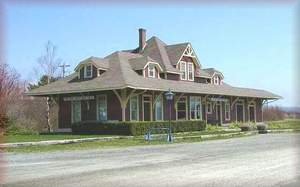 |
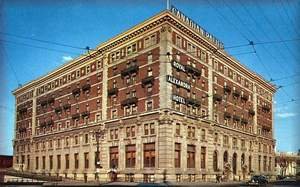 |
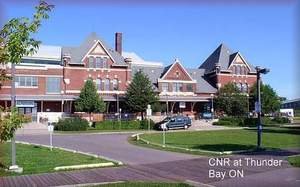 |
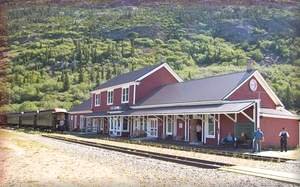 |
|
|
|
|
|
Calgary's Heritage Park Historical Village
Links to the other areas of Canada
 |
 |
 |
 |
|
|
|
|
|
|
Heritage Park is situated on 127 acres of land at 1900 Heritage Drive SW, just 20 minutes from downtown Calgary. It opened its gates to the public on July 1, 1964 and is Canada's largest living history museum, featuring a village recreated to appear as it might have been, in early-20 Century Alberta. Most of the buildings are historical and were transported to the park at the end of their life. The Park features a Railway Area, which includes a roundhouse, car shop and a turntable built in 1907. The roundhouse and car shop are open to the public and the turntable is heavily used during Railway Days, a 2-day affair usually on a July or August weekend. Access www.heritagepark.ca for more details. |
 |
Long before there were LED crossing lights, there
was the wigwag signal.
In small towns, the changeover to crossing lights, was as late as the 1980s. There were several models produced in US and Canada. The US models had a slightly different design. This view shows the model in very wide use, all over Canada by CN and CP. Just like today, as a train approached the road crossing, a spring released the arm and the signal oscillated back and forth under control (hence the name wigwag), while a large bell above rang with a "ding-dong" sound matching the swinging of the arm, to warn motorists and public. After the train had passed, the arm retracted into the cover and locked and the bell silenced until the next train. |
| This picture was taken and submitted by Massey F. Jones | |
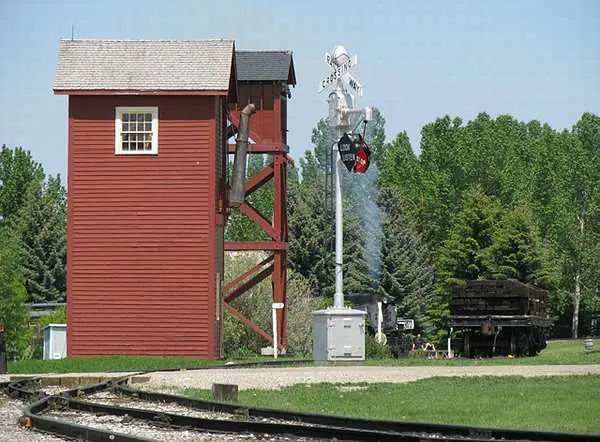 |
The square water tower at Calgary's Heritage Park
still provides a steady supply for steam locomotives CP2013
and CP2014 during the Park's open season from May to September. Notice one of the smoke plume of a steam engine in the background. The locomotive in use that day is watered around 5:30pm, near the park's closure. Note the wig-wag signal, featured elsewhere on these pages. The Railway Water Tower was built in 1902 and the adjacent Railway Sand House, circa 1920. |
| This picture was taken and submitted by Massey F. Jones | |
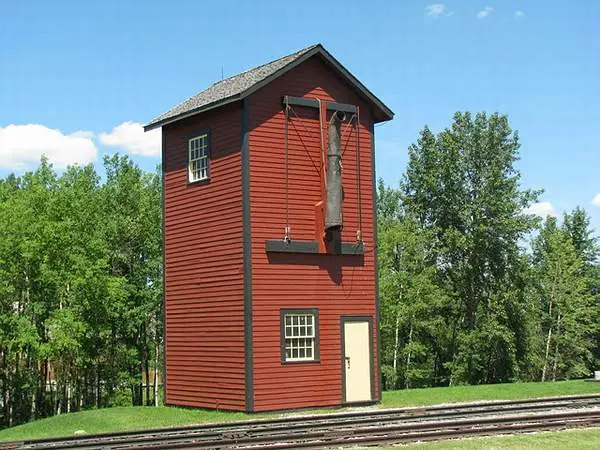 |
During steam days, smaller locomotives needed
to be filled with water for their boilers about every 50 miles or so. One common type was the octagonal enclosed water tower with a ball on a central mast to indicate the level, such as at Glenboro MB and Kenaston SK. They contained a heater to prevent water from freezing in winter. As years went by, bigger centres, such as Brandon MB had large steel tanks. All three examples are shown on the Stations page: http://yourrailwaypictures.com/TrainStations/index Central.html This one at Heritage Park is a rectangular water
|
| This picture was taken and submitted by Massey F. Jones | |
.jpg) |
A Heritage Park staff member demonstrates
how the locomotive water tender is replenished on the CPR 2023 hauling a freight train, during Railway Days, September 28-29, 2013. During the open season May-October, either
|
| This picture was taken and submitted by Massey F. Jones | |
.jpg) |
Sand provides help with braking and traction on
icy rails but Heritage Park locomotives do no t usually operate during the winter. This sand house is never used, firstly because it
During the 1920s, the Canadian Pacific Railway
|
| This picture was taken and submitted by Massey F. Jones | |
.jpg) |
Shepard Station at Calgary's Heritage park, 1900
Heritage Drive SW. Shepard is still an active CPR point on their Brooks Sub between Medicine Hat and Calgary, (about 10 miles east Calgary's Alyth Yard). CPR named the station after one of the contractors
|
| This picture was taken and submitted by Massey F. Jones | |
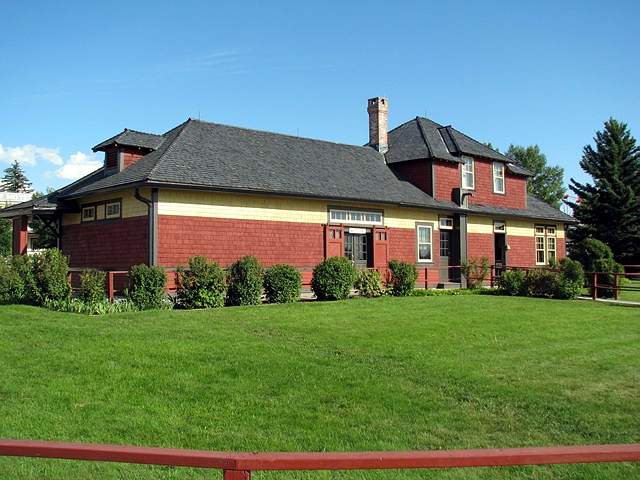 |
The rear of Shepard Station.
The large portion on the left side was the freight
shed
http://www.heritagepark.ca/plan-your-visit/attractions
|
| This picture was taken and submitted by Massey F. Jones | |
.jpg) |
The station, built in 1910, was donated to Heritage
Park
by the CPR when it became vacant and now provides visitors with ticket sales, food services, water fountain and public washrooms. It is also wheelchair accessible. The far side features a small lunch counter with a few tables. |
| This picture was taken and submitted by Massey F. Jones | |
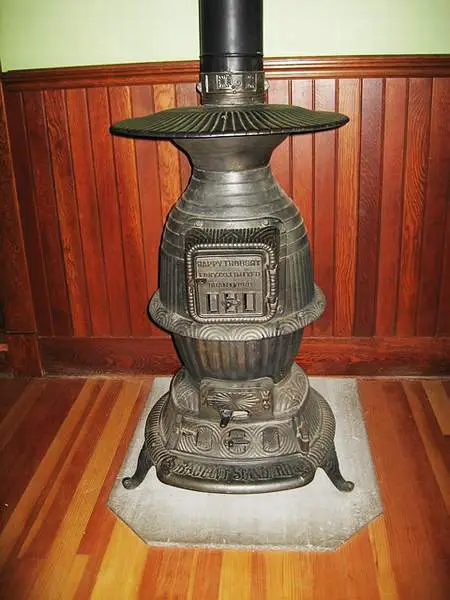 |
The "Happy Thought Standard" stove in Shepard station
at Heritage Park. Each one of their 3 stations has an al old fashion stove that they use only as an artifact. The "Happy Thoughts" stove brand was first
|
| This picture was taken and submitted by Massey F. Jones | |
__crop.jpg) |
A close-up of the Happy Thought Standard stove.
Like all other early stoves, the middle door was
|
| This picture was taken and submitted by Massey F. Jones | |
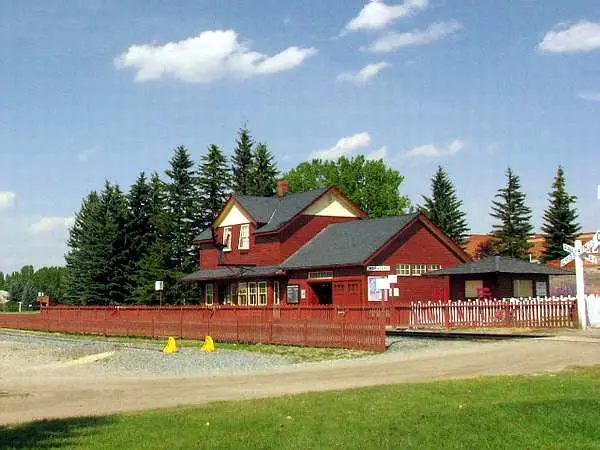 |
Midnapore Station, built in 1910 of the CPR Type A-2
design.
The station, located in the deep south part of the Calgary used to be called Fish Creek" but the postmaster renamed it Midnapore when he saw a letter addressed to Midnapore India, mixed in with Fish Creek's mail. The station was always occupied by a single station
agent who lived upstairs with his wife, before moving on to other stations.
Before 1972, Midnapore Station served as the
|
| This picture was taken and submitted by Massey F. Jones | |
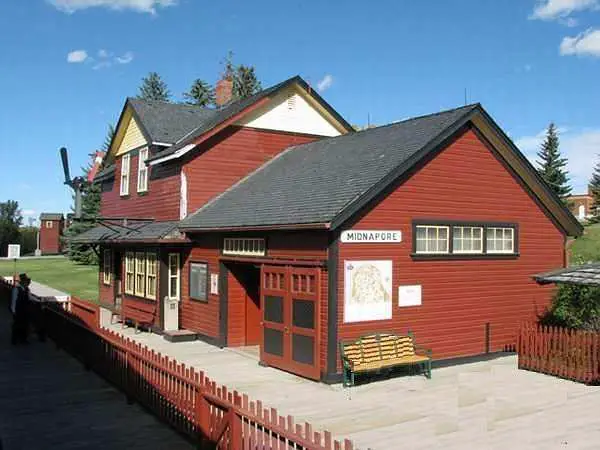 |
Approaching Midnapore Station from the south,
viewed from the train. |
| This picture was taken and submitted by Massey F. Jones | |
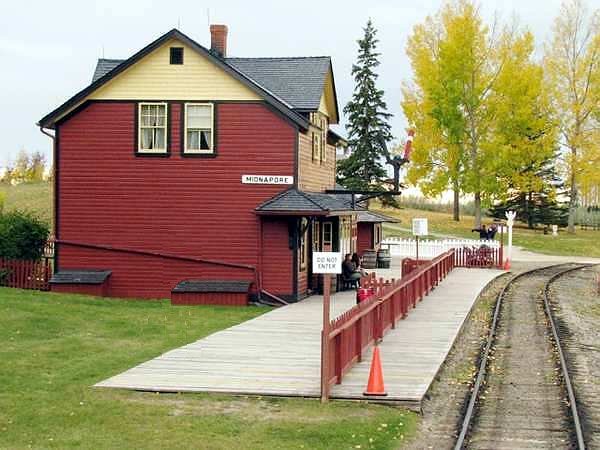 |
Midnapore Station, looking south from the train |
| This picture was taken and submitted by Massey F. Jones | |
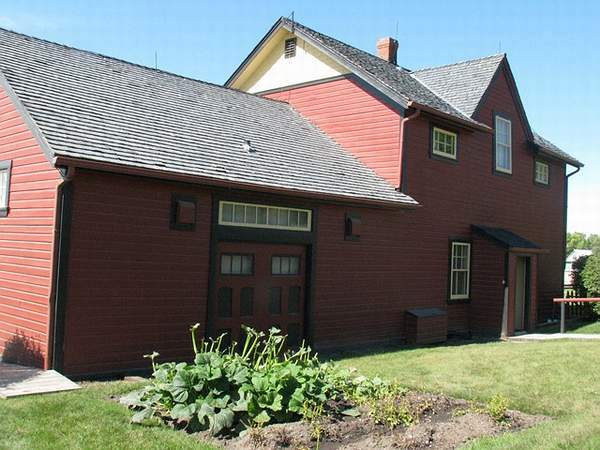 |
The rear of Midnapore Station.
This area was more or less reserved for the stationmaster's
http://www.heritagepark.ca/plan-your-visit/attractions
|
| This picture was taken and submitted by Massey F. Jones | |
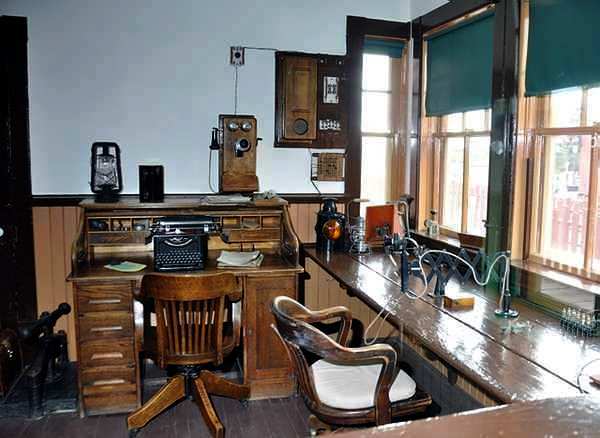 |
The Station Agent desk with customer counter in
the foreground. |
| This picture was taken and submitted by Massey F. Jones | |
.jpg) |
A common sight for passengers entering a 1910 of
the CPR Type A-2 design. To the left, the YWCA Traveller's Aid, available to help young ladies during their journey with information, etc. |
| This picture was taken and submitted by Massey F. Jones | |
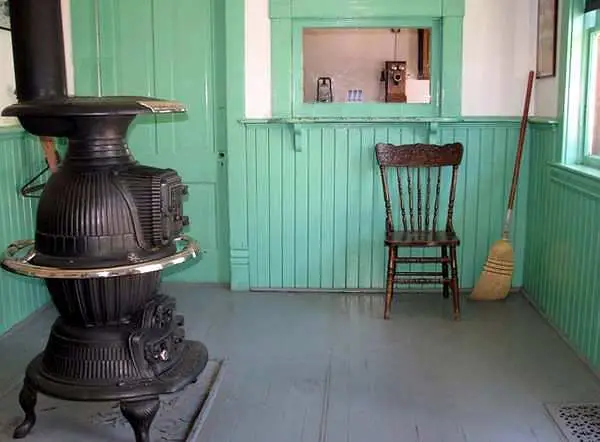 |
Inside Midnapore Station looking south, with customer
service through the rectangular window.
Like other railway stations in Heritage Park except
Because it got very hot when in use, the stove was
|
| This picture was taken and submitted by Massey F. Jones | |
.jpg) |
The door of the potbelly stove was hinged to insert
wood inside or take out the ashes. When hot, a poker (used to
stir up the wood within the firebox while burning), was used to prevent burned fingers. The knob in the center grate helps control the draft within the firebox. Notice the nickel-plated skirt around the stove.
|
| This picture was taken and submitted by Massey F. Jones | |
.jpg) |
Close ups of the pot-bellied wood stove at Midnapore
Station.
The Station Agent stove was manufactured specifically for the railroad companies to heat their stations. The flat top could be used for cooking or water boiling. This one was built around 1905. The stove is 48" tall and 24" in diameter. Today, one of these in restored condition sells for around $4000.00 |
| This picture was taken and submitted by Massey F. Jones | |
.jpg) |
View the Gurney 1892 line of stoves at: http://www.stovebook.com/1892_Gurney_Stove_
Catalog.pdf and make a note of prices for their products, such as $67.50 for a large 10 cooking hole kitchen range. Equivalents of this model pot-bellied wood stove for home use, sold for around $19.00 at the time. Today, we can move the decimal completely to the right.
|
| This picture was taken and submitted by Massey F. Jones | |
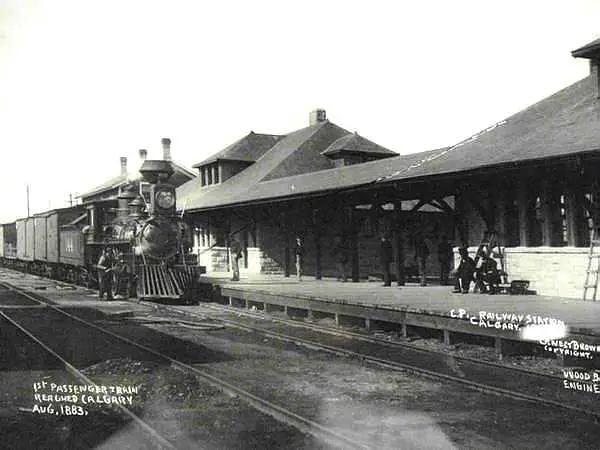 |
CPR # 144 at Calgary station.
The caption states that the first passenger train reached Calgary Aug 1883. This is the second station in Calgary (the first was a boxcar). Both buildings were eventually taken down when a much larger station was built a block further west. One building then became the High River CPR station, the other the Claresholm CPR station, both a few miles south of Calgary. On 28 Jul 2010, the High River station (now Museum of the Highwood) sustained fire damage |
| This pictures is from a framed photograph in a Calgary
restaurant.
It was submitted by Massey F. Jones |
|
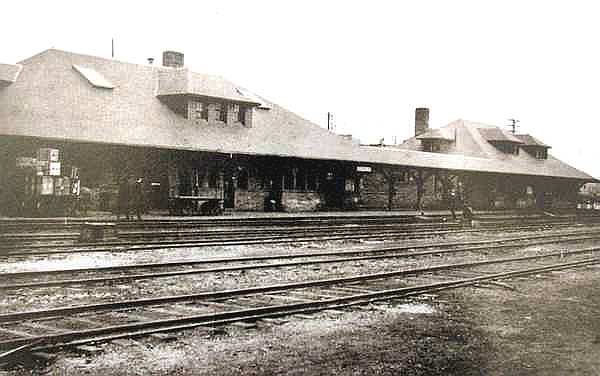 |
This plaque, affixed to a wall of the Calgary CPR
Station replica at Heritage Park depicts the 3rd Canadian Pacific Station
at 9 Avenue and Centre Street South in Calgary,
in a trackside view looking north in 1909. Constructed in 1893, the station was built of locally
The High River CPR station subsequently renamed "Museum
of the Highwood" and housing railway and ranching artifacts, was damaged
by a fire on July 28th,
The original image is from the
|
| This picture was submitted by Massey F. Jones | |
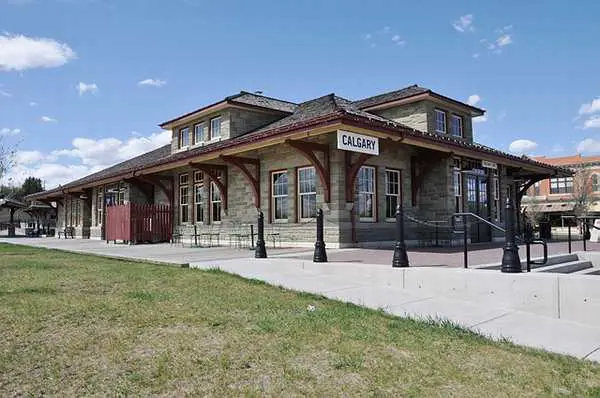 |
In 1989-1990, the Heritage Park main gate was relocated
and the park went through an expansion. To serve the needs, a replica of the 1893 Calgary CPR station was constructed to serve visitors needs with an orientation centre, and a restaurant (Railway Café) which is designed in the traditional CPR theme. Due to its location in Heritage Town Square,
just
|
| This picture was taken and submitted by Massey F. Jones | |
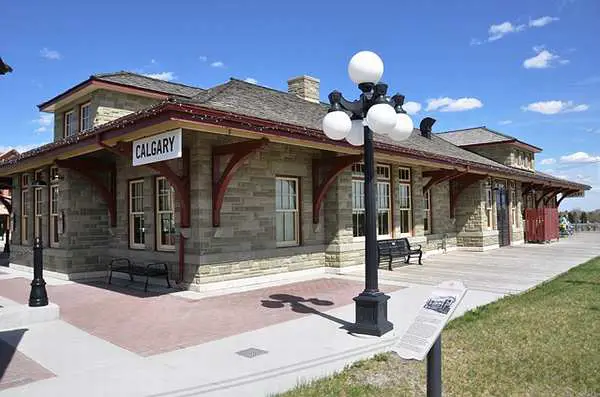 |
A back view of the 1893 Calgary CPR station.
Notice the fine workmanship, using modern materials. |
| This picture was taken and submitted by Massey F. Jones | |
.jpg) |
The CPR Garden stands adjacent to Heritage Park Town Square, the site of some artisan shops including a portrait studio (in turn-of-century clothes), a tutorial-type micro brewery as well as an old fashioned bandstand, the site of periodic free concerts. |
| This picture was taken and submitted by Massey F. Jones | |
.jpg) |
Railway gardens began to be planted in the 1890s by
station agents wanting to hide railway construction around their station. Soon, there was competition between them, to see who had the best garden. In addition to beautifying the station, gardens provided a rest area for travelers between trains, especially for those who could then walk their pets. |
| This picture was taken and submitted by Massey F. Jones | |
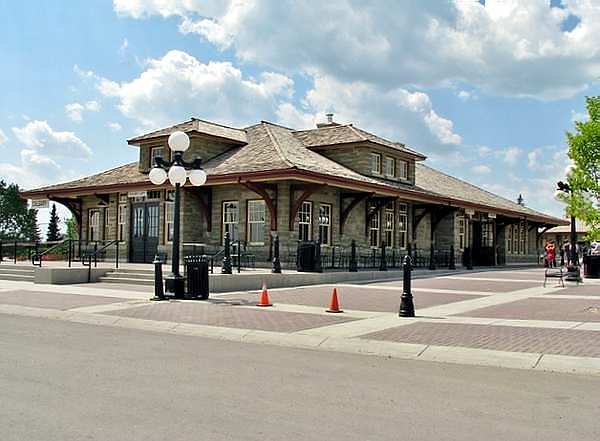 |
The front side of the 1893 Heritage Park replica CPR
station, viewed from the Heritage Town Square in May 2013. The steps lead to the main entrance of the Railway Cafe; their dining venue outside the main gate |
| This picture was taken and submitted by Massey F. Jones | |
.jpg) |
While wealthy passengers usually went to the adjacent
hotel for a meal during a train layover; hundreds who passed through Calgary yearly patronized the station's lunch counter, offering soup, sandwiches, pastries and coffee at a more affordable price. The Railway Cafe seeks to replicate the elegance of a 1930s lunchroom. The 3rd Calgary CPR Station featured two buildings
|
| This picture was taken and submitted by Massey F. Jones | |
.jpg) |
Visitors entering from the Heritage Town Square make
their selection at the far right and then can either move to a couple of nearby tables or into the dining area on the other side of the curved counter, for more privacy. |
| This picture was taken and submitted by Massey F. Jones | |
.jpg) |
Entering the double doors (pictured elsewhere), brings
visitors directly into the lunchroom In keeping with
tradition; there are stools along the counter for single diners and those in hurry, as well as tables for families or those with more time to spare between trains. Notice the coffee grinder on top; as at the turn of the last century, instant and pre-packaged coffee did not yet exist. Due to its location before the Park gates in Heritage Town Square, the Railway Café requires no park admission. It is open year-round and serves a light fare, all dishes being prepared on-site and priced at $15 or less. Once inside the gates, there is more food available, ranging from ice cream and homemade pastry to fine dining.
|
| This picture was taken and submitted by Massey F. Jones | |
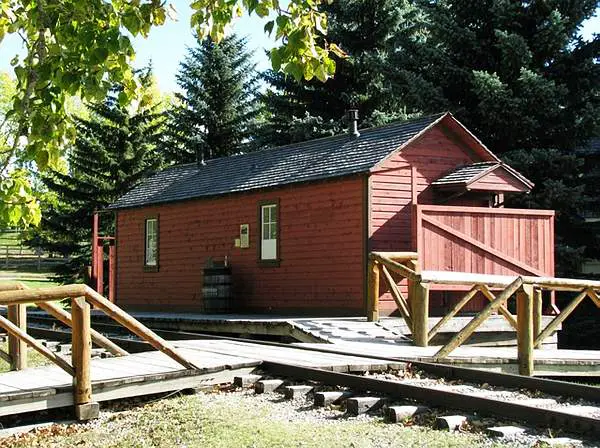 |
The Canadian Pacific was laying track West at such
a
pace before 1914, that it didn't have time to build a proper station in every hamlet located trackside to serve farmers and homesteaders. To remedy the situation, the railway dropped off a
Bowell station at Heritage Park was the actual 1909
Canadian Pacific Railway donated the building
to
|
| This picture was taken and submitted by Massey F. Jones | |
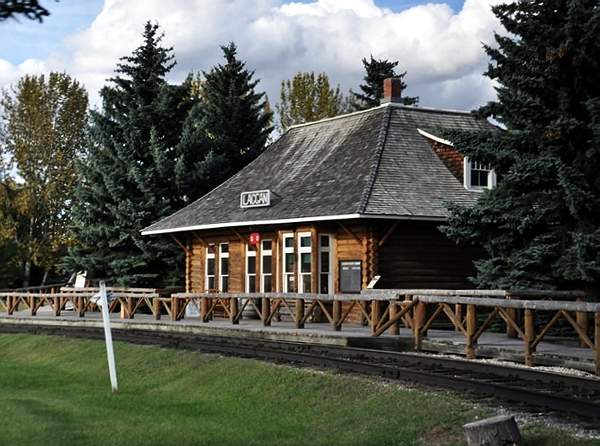 |
Laggan Railway Station, at Heritage Park is the original
Lake Louise train station, built of peeled logs in 1891. In 1909, the structure was converted to a baggage shed when a new more spacious log station was built at Lake Louise. Surplus to CPR requirements, the baggage shed was dismantled 1976 and moved to Heritage Park where it was reassembled and restored to its original beauty. When this station was in use, horses carried passengers
|
| This picture was taken and submitted by Massey F. Jones | |
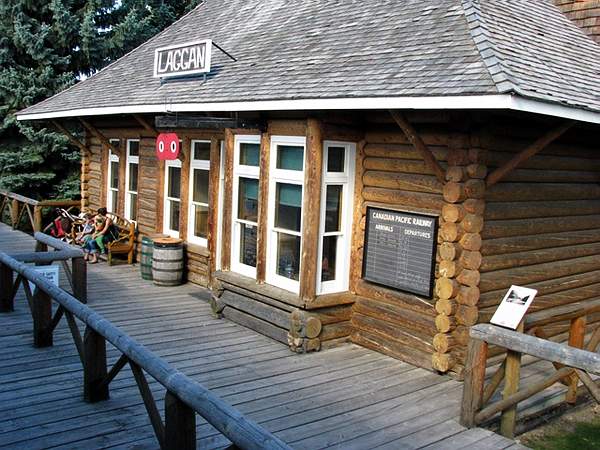 |
Ironically.,the log station which replaced the
structure
shown in this picture, was itself converted into a trackside restaurant, when VIA Rail abandoned passenger service through the CPR Laggan Subdivision in January 1990. Freight trains and special runs still use the track at all hours but do not stop at Lake Louise anymore. |
| This picture was taken and submitted by Massey F. Jones | |
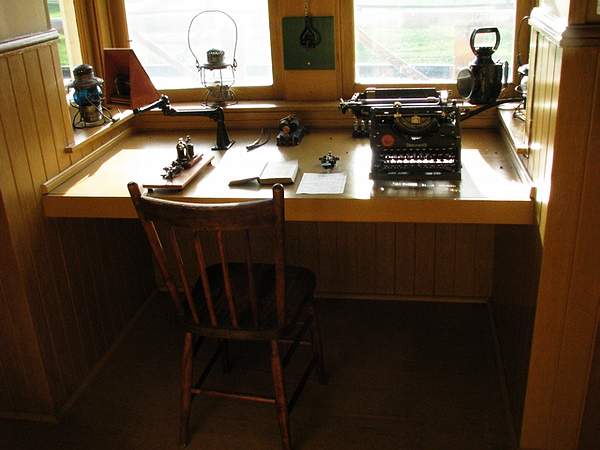 |
The operator's station at Laggan Station in Heritage
Park.
Some basic tools are seen, consisting of railway lanterns, telegraphy equipment, as well as an Underwood typewriter. The green board in the centre of the picture between
the windows, holds a chain for working the track signal
Laggan Station is serviced by the Heritage Park steam
|
| This picture was taken and submitted by Massey F. Jones | |
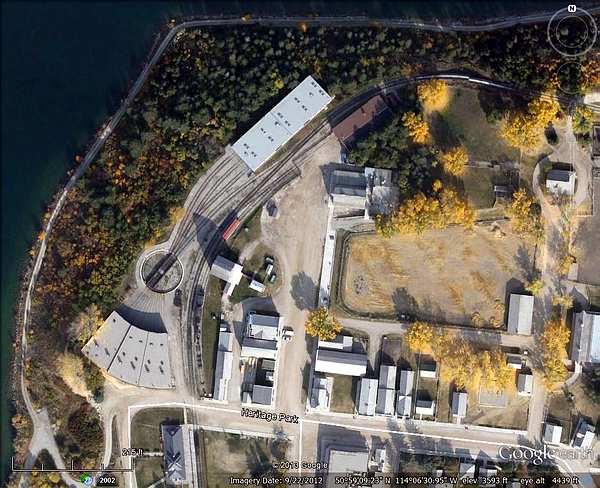 |
Heritage Park Roundhouse and Car Shop
The car shop is on the top and the roundhouse
|
| This picture was submitted by Massey F. Jones. It was taken from Google Earth | |
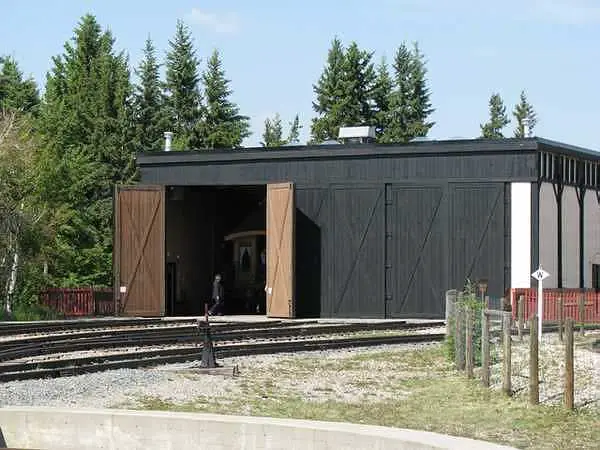 |
The Railway Car Shop is open to the public at
Calgary's Heritage Park. It houses several preserved historic cars from the 1880s to the 1920s, with the average being from 1910. One of them can be seen just inside the open doors. Part of the turntable pit can be seen in front. |
| This picture was taken and submitted by Massey F. Jones | |
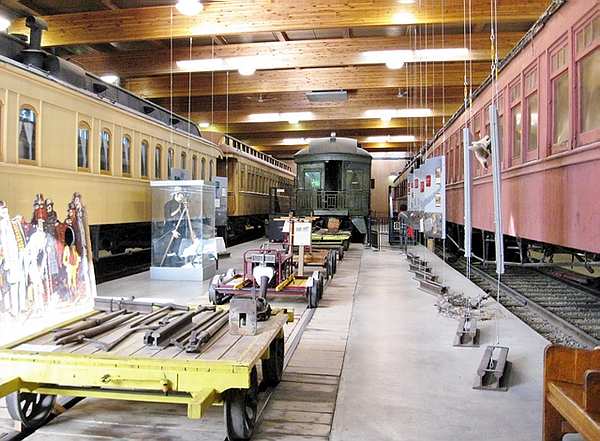 |
The interior of the car shop at Heritage Park in
September 2013. Left-to-Right: Car 76 "Construction Car" (1882),
The interior of the Colonist Car will be covered on
|
| This picture was taken and submitted by Massey F. Jones | |
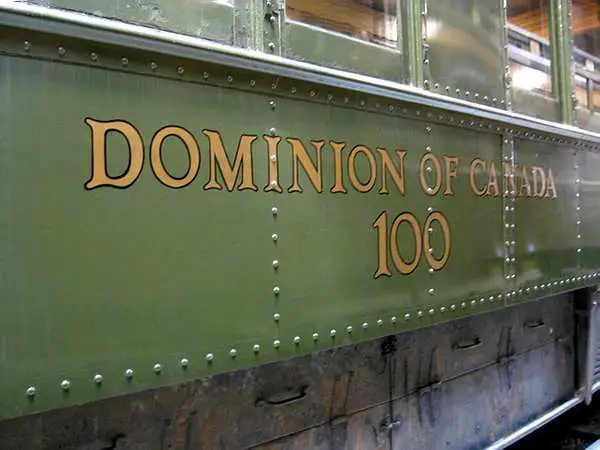 |
Among the artifacts preserved because of historical
value,
is the Car 100 YORK, now located in the Car Shop at Heritage Park. It was constructed in September 1901 for the Royal
Train,
After being acquired by the Federal Department of
|
| This picture was taken and submitted by Massey F. Jones | |
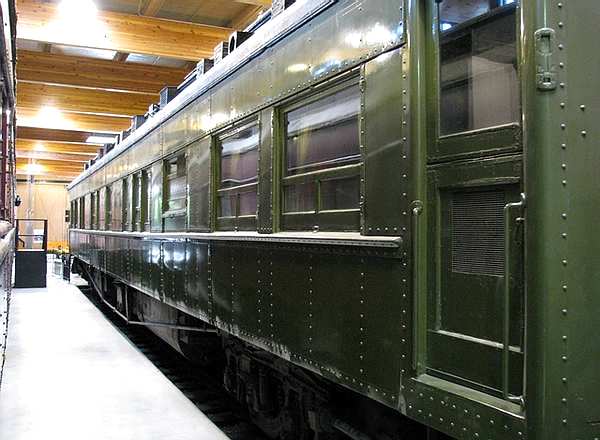 |
Car 100 YORK went through renumbering several
times in the Canadian National passenger car series, before coming to Regina in 1985 as a Simpson Sears executive car and to Heritage Park some time later. |
| This picture was taken and submitted by Massey F. Jones | |
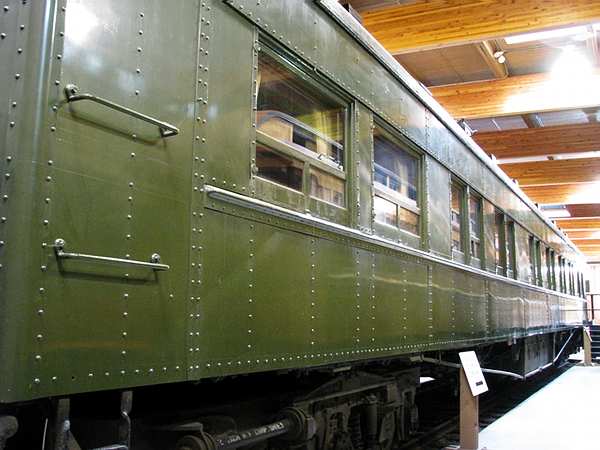 |
A platform at the front end of the car allows
visitors to inspect the opulent interior of heavyweight passenger car 100 YORK |
| This picture was taken and submitted by Massey F. Jones | |
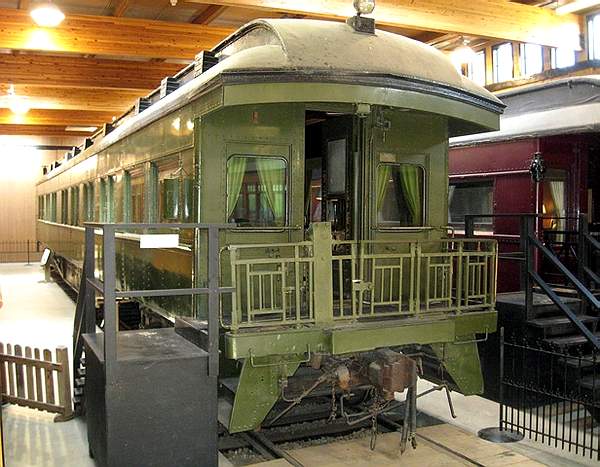 |
The rear platform of Car 100, viewed from another
exhibit in the Heritage Park Car house. |
| This picture was taken and submitted by Massey F. Jones | |
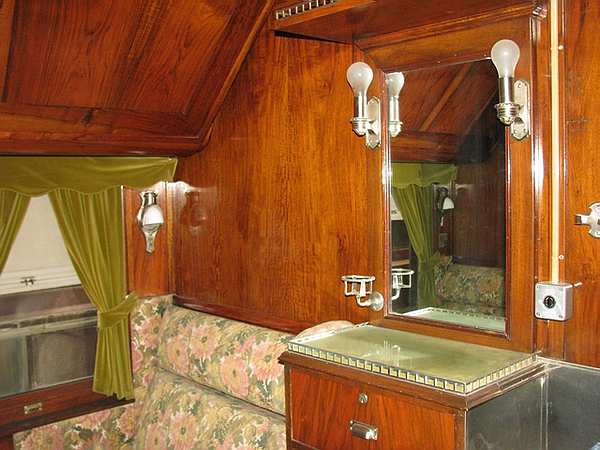 |
A bedroom in one of the sections, presumably no
for the VIP himself, as it features a fold down bunk at top left. Notice the fine wood grain. The car is planned for restoration at a later date. |
| This picture was taken and submitted by Massey F. Jones | |
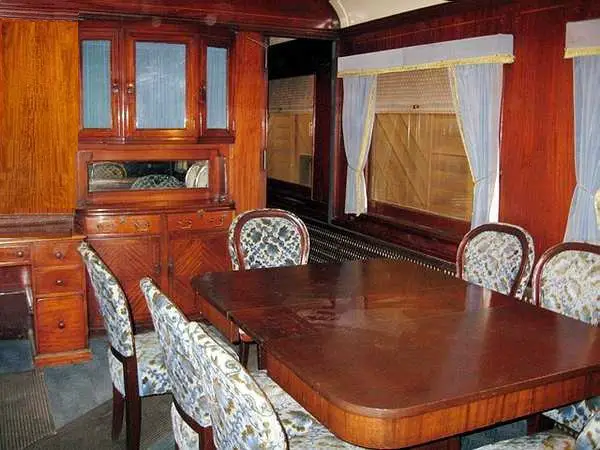 |
The intimate dining area of passenger car 100 YORK |
| This picture was taken and submitted by Massey F. Jones | |
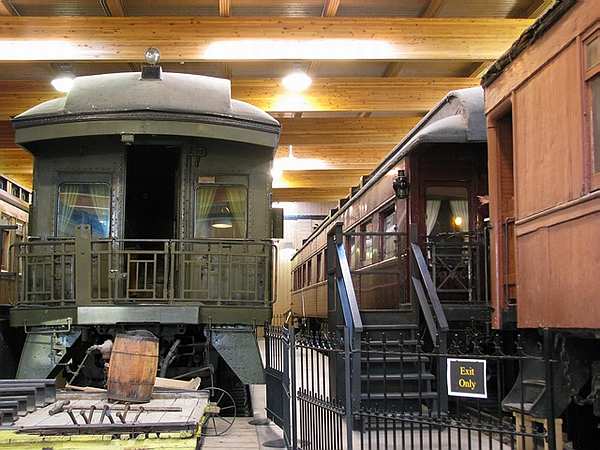 |
Displayed in the Heritage Park Car Shop at
one end
of the Colonist Car in the foreground and car 100 YORK to the left, is the historic car RUPERTSLAND. There are a couple of references to the car in the
text on
The car was constructed in built in January 1905 and
The stairs in the foreground make the interior of the car available for viewing by visitors, during the Park's open hours. |
| This picture was taken and submitted by Massey F. Jones | |
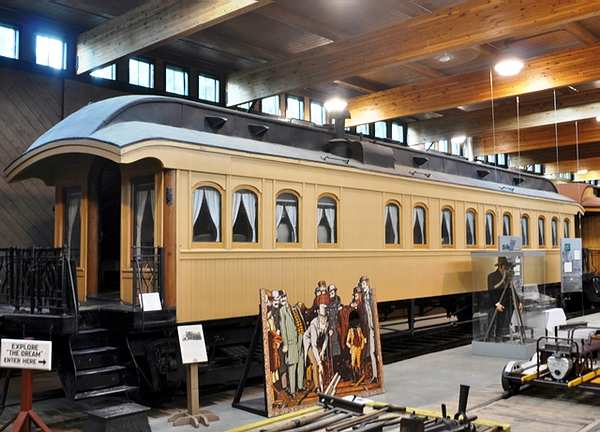 |
Canadian Pacific Railway Car 76, one of the rarest
pieces
of Canadian railroad history. This is not a replica, but the actual car which was used for transporting dignitaries from Calgary. Lord Strathcona drove the last spike and marked the completion of the Canadian Pacific Railway on November 7, 1885, west of Revelstoke in Eagle Pass . http://commons.wikimedia.org/wiki/File:LastSpike _Craigellachie_BC_Canada.jpg Still well able to be on the mainline; it returned
there in November 1985, led by steam locomotive CPR 1201 (shown in these
pages) with a special train of today's dignitaries,
Car 76 was built by Harlan and Hollingsworth in May
1882
|
| This picture was taken and submitted by Massey F. Jones | |
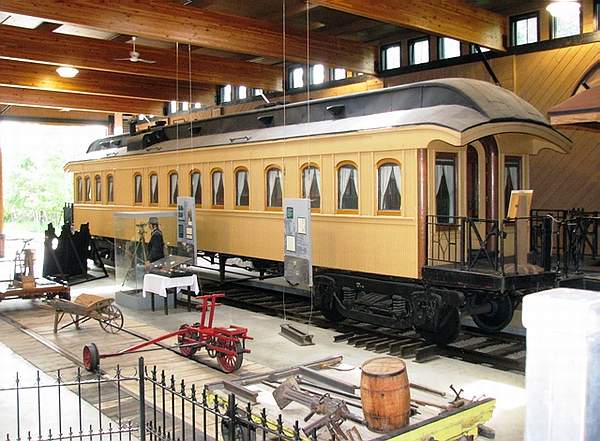 |
Car 76, on display in the Railway Car Shop was present
at the driving of the last spike Canadian Pacific Last Spike, joining East
and West on the morning of November 7, 1885 and again at the 100th anniversary
in Craigellachie, B.C in November 7, 1985 during the ceremonies.
The century-old car is fully roadworthy and approved for mainline track.Craigellachie is featured on my station page http://yourrailwaypictures.com/TrainStations/indexBC.html |
| This picture was taken and submitted by Massey F. Jones | |
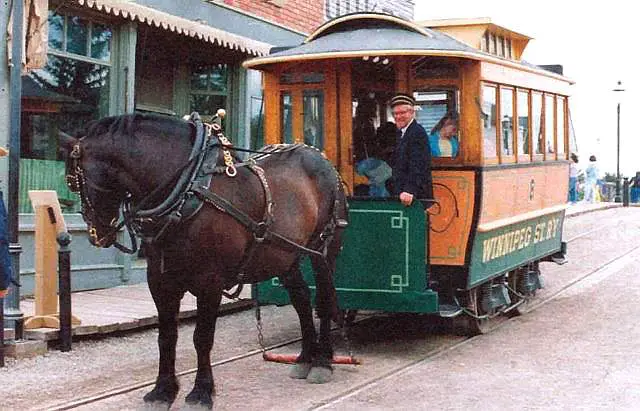 |
In 1972, Heritage Park built a replica of a four-wheeler
horse drawn streetcar used on the Winnipeg Street Railway. The route inside the Park was extended in 1973 and it operated the Winnipeg Streetcar #8 until 1990. It was moved into the Railway Car Shop as a permanent display in 1998. Winnipeg operated an animal railway from 20 October
|
| This picture was submitted by Massey F. Jones, courtesy Heritage Park | |
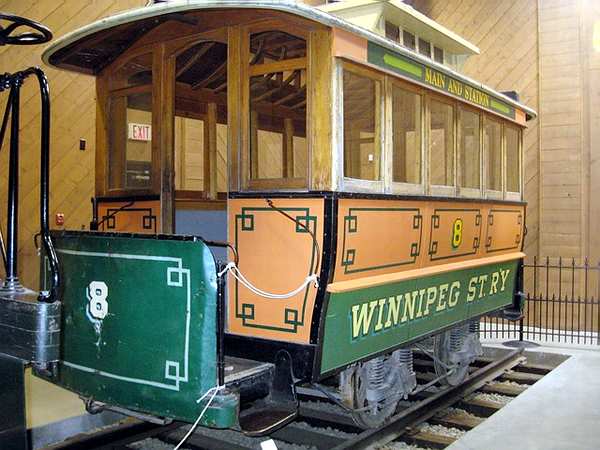 |
The car is now on permanent display in pristine condition
at the back of the back of the Car House. The minimal friction of steel wheels on steel rails (or iron on iron) allowed a horse to pull a larger load and make better time than he could with a road vehicle. Public Transit, in the form of horse car, first ran
in
|
| This picture was taken and submitted by Massey F. Jones | |
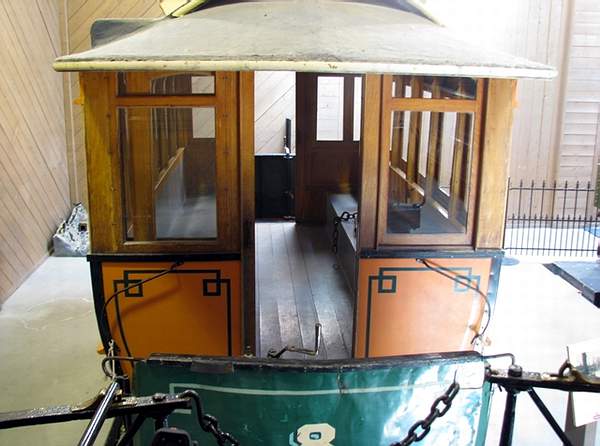 |
The front end of horse car #8, showing the interior
as
seen by the public exiting the platform of "Construction Car" #141. The steel crank above the dash is the hand brake, used
|
| This picture was taken and submitted by Massey F. Jones | |
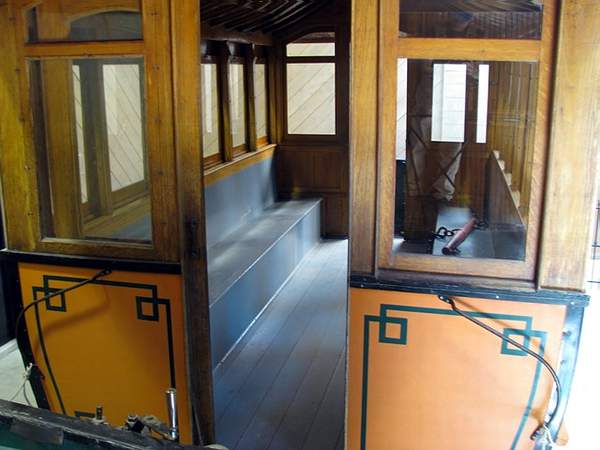 |
At befits the period, the interior of an 1880 horse
car
is extremely basic as it is merely used to transport people between 2 points out of the weather. And in its day, the seats of Winnipeg horse cars must have been just plain varnished wood. Among other Winnipeg Transit facts, there's a period
|
| This picture was taken and submitted by Massey F. Jones | |
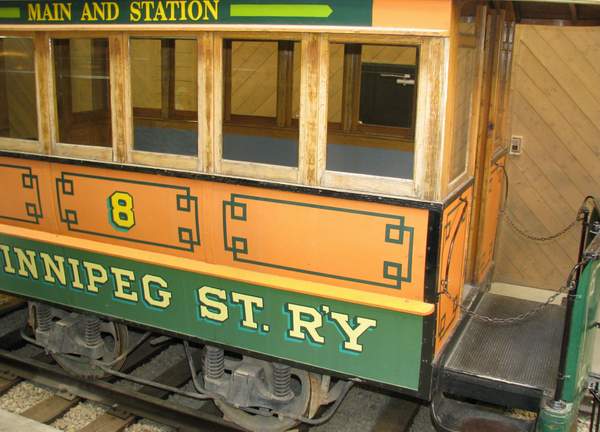 |
The rear of Winnipeg St. Ry replica on permanent
display in the Heritage Park Car House. This gives a very good idea of graphics applied to the car. |
| This picture was taken and submitted by Massey F. Jones | |
.jpg) |
The south wall of the Heritage Park roundhouse on
22 Sep 2-13. To the far right is CP Jordan Spreader 402829 and
The gentleman with the broom in the centre is one of
the costumed Heritage Park staff, on site to explain railway artifacts
to visitors.
|
| This picture was taken and submitted by Massey F. Jones | |
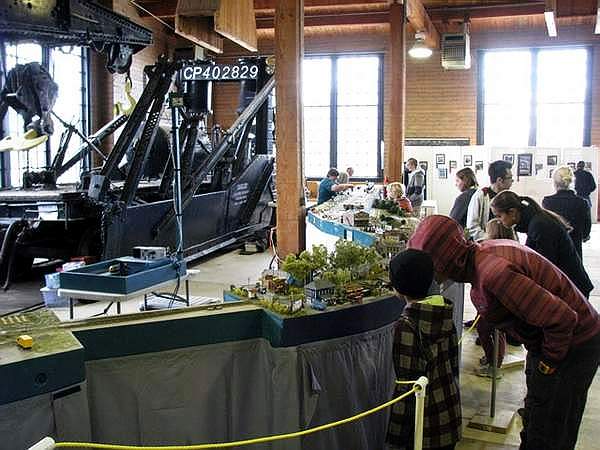 |
An area of the Heritage Park was set aside for
model railroader layouts during Railway Days; September 28-29, 2013.Railway
Days are designed to showcase the long history of railway in Calgary with
turntable
demonstrations, locomotive watering and model railroading from local clubs. The two days also feature spike driving, double heading by their 2023 and 2024 with freight and passenger cars, as well as displays of the Park's rail artifacts in various areas, with interpretation by knowledgeable staff. This year it provided hand car rides for young and old on a short bit of track. Young staff member on one side and guest pumping on the other side. In the back, Jordan Spreader CPR 402829 (built 4/1912), about to undergo restoration. The hook of 75-Ton Bucyrus steam crane 414328 can also be seen at the far left centre. It is also undergoing restoration. Both are featured on this page. |
| This picture was taken and submitted by Massey F. Jones | |
.jpg) |
Snowplow 400884 was built December 1911 in the
CP Montreal's Angus Shops and originally numbered 300884 before getting its new number in 1991. It is now displayed in Calgary's Heritage Park roundhouse, alongside a few other artifacts. |
| This picture was taken and submitted by Massey F. Jones | |
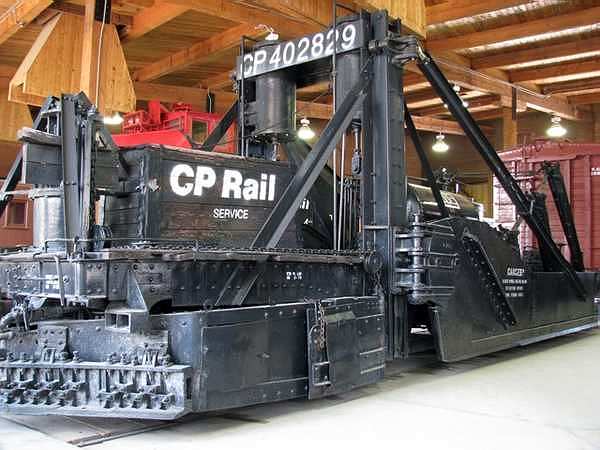 |
Jordan Spreader CP402829 sits in the Heritage Park
roundhouse in Calgary. It was built in Southern Ontario
in April 1912 (ser# 229) and still bears its original number. |
| This picture was taken and submitted by Massey F. Jones | |
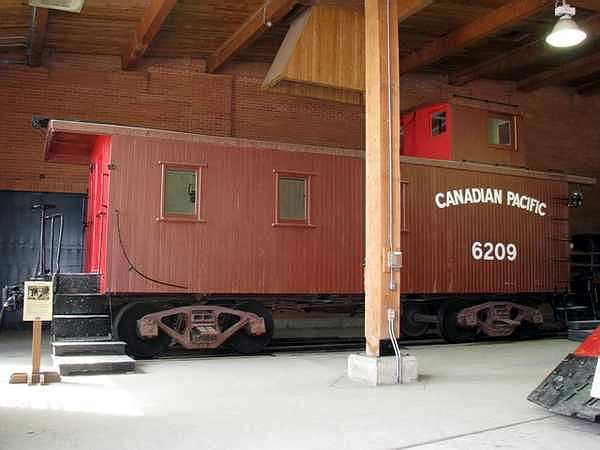 |
CP wood slat caboose 6209 was built in 1912 as 436209.
It sits in the roundhouse at Calgary's Heritage Park and is in regular service when a freight train is put together. |
| This picture was taken and submitted by Massey F. Jones | |
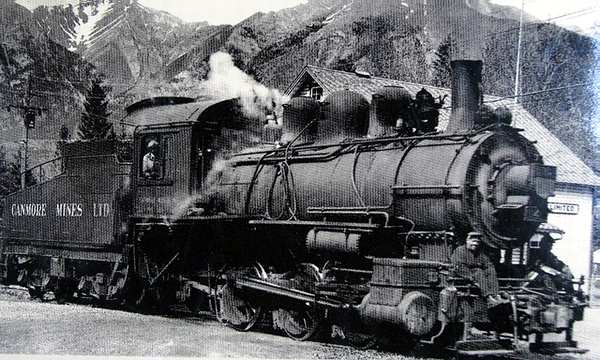 |
Canmore Mines #4 while in operation.
It was built by the Canadian Pacific in February 1905 and they numbered it 2144 in 1912, then 6144 in 1943. It is a 0-6-0, which means no leading or trailing trucks and was mostly used as a switcher by CP, before being sold to Canmore Mines around 1963. After Canmore Mines Ltd. ceased coal production in
1979, the locomotive was eventually donated to Heritage Park
Canmore, about 20 km east, became the overflow for
|
| This picture submitted by Massey F. Jones | |
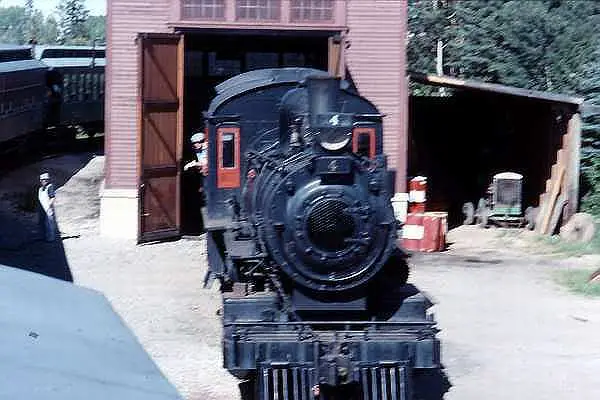 |
Ex Canmore Mines #4, now "Canadian Pacific 2018,"
taken on the run from a caboose, during Heritage Park Railway Days, September 1992. It is about to be run for the public, as can be seen in the next picture, after our train has cleared the track. Heritage Park Railway Days is an annual 2-day event; where double heading, switching turntable operation and other rail-related events take place. Access www.heritagepark.ca for the current dates. |
| This picture was taken and submitted by Massey F. Jones | |
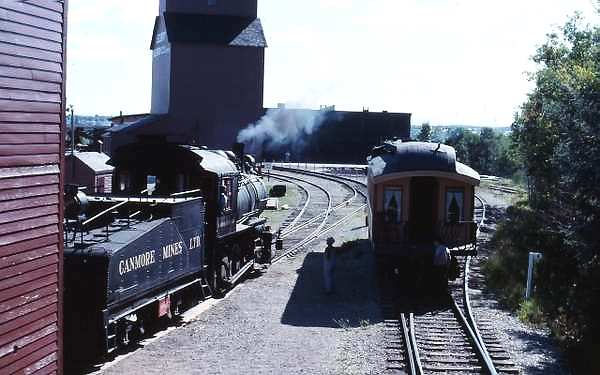 |
A rear view of Canmore Mines #4 about to go on the
Heritage Park "mainline", in a photo, again from the caboose. The 0-6-0
locomotive, built by the CPR in
February 1905 (Ser# 1392) has now been converted to diesel power and the exhaust plume can be clearly seen in the photo as it is preparing to depart . Compare the #4 to the photo of the CP 2018 on this page, when it's now wearing a nose cone for display. We have left a historic car behind and the #4 will now switch it for the Railways Days visitors. |
| This picture was taken and submitted by Massey F. Jones | |
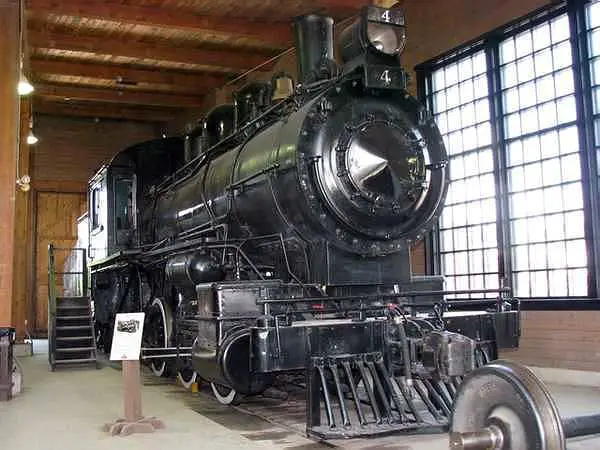 |
CP2018 on static display in the roundhouse at
Calgary's Heritage Park was built by the CPR in February 1905
(Ser# 1392). It was in service as CP2144 in 1912, then CP 6144 in 1943. It next bit of service was at Canmore Mines (near Banff AB) as their No 4., before being acquired by Heritage Park, who converted it to diesel power. It is presumed that the nose cone is removed (for air intake) when the loco is running. |
| This picture was taken and submitted by Massey F. Jones | |
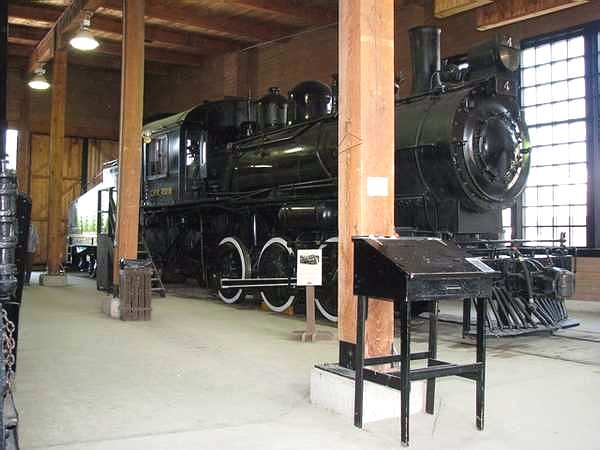 |
Notice the steps leading into the cab for public viewing
in the Calgary Heritage Park roundhouse |
| This picture was taken and submitted by Massey F. Jones | |
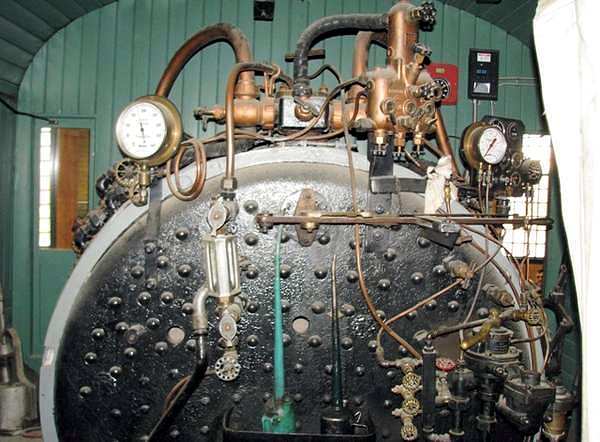 |
One of two views of the CP2018 gauges, some modified
from the original concept because the former steam loco is now dieselized |
| This picture was taken and submitted by Massey F. Jones | |
.jpg) |
One of two views of the CP2018 gauges, some modified
from the original concept because the former steam loco is now dieselized |
| This picture was taken and submitted by Massey F. Jones | |
.jpg) |
The rear of the roundhouse at Heritage Park, built
to
provide a repair facility for their rolling stock and showcase a few exhibits indoors, in addition to their Car House on the other side of the turntable. It represents a typical CPR roundhouse in Western Canada before 1915. The roundhouse is always open to the general public during the park operating hours. This view is the east wall from Shepard Station, next door. Heritage Park does 95% of its maintenance on site.
|
| This picture was taken and submitted by Massey F. Jones | |
 |
2023 at Shepard Station in Heritage Park.
In this photo, the locomotive is pulling a freight train during Railway Days 28-29 Sep 2013. |
| This picture was taken and submitted by Massey F. Jones | |
 |
A semi-telephoto shot of Heritage Park 2024, clearly
showing air cylinders and apparatus at the front. The locomotive is waiting at Laggan Station. |
| This picture was taken and submitted by Massey F. Jones | |
.jpg) |
The wheel arrangement of CPR 2024, during a rest stop
at Shepard Station in Heritage Park. CPR is a 0-6-0 locomotive, meaning that it has no
Like her sister CPR 2023, the 2024 was never owned
|
| This picture was taken and submitted by Massey F. Jones | |
.jpg) |
Another view of the CPR 2024 wheel arrangement
and connecting rods. The railway at Heritage Park uses 100-pound rail
|
| This picture was taken and submitted by Massey F. Jones | |
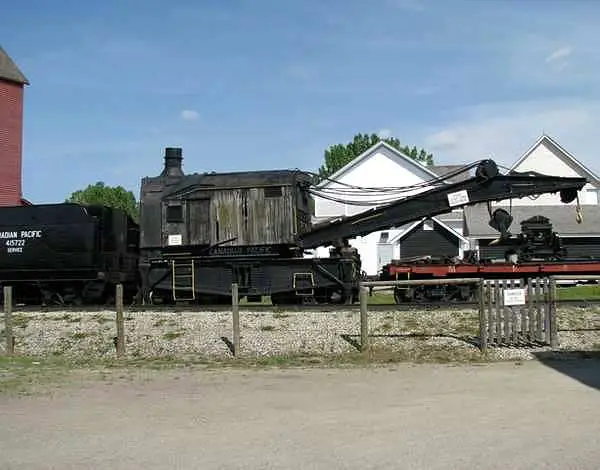 |
Yet to be restored is 75-ton Steam Crane 414328 built
by Bucyrus in 1920 (Ser#181) and placed in service as CP 400167 about 1930, before being renumbered with its present one. The tender was part of a small 0-6-0 locomotive. The item on top of the flatcar is a small mine car, yet to be restored also. |
| This picture was taken and submitted by Massey F. Jones | |
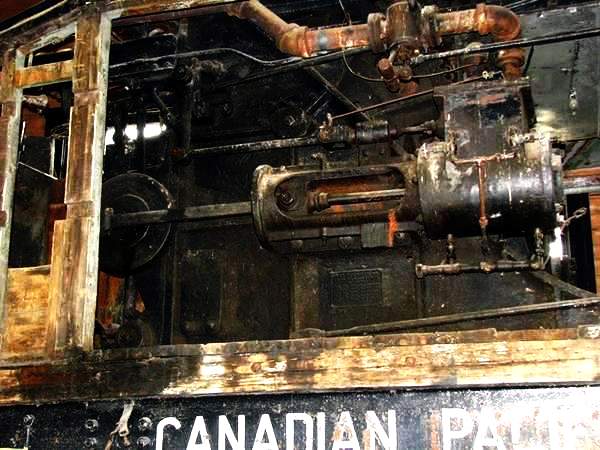 |
One of the piston rods activating the Canadian Pacific
414328, 75-Ton Bucyrus Steam Crane, can clearly be
seen here inside the Heritage Park roundhouse in September 2013; as the sides has now been taken off for restoration and viewing. Heritage Park has a history of restoring their artifacts to superb quality. You can see the rod and piston in operation on the
|
| This picture was taken and submitted by Massey F. Jones | |
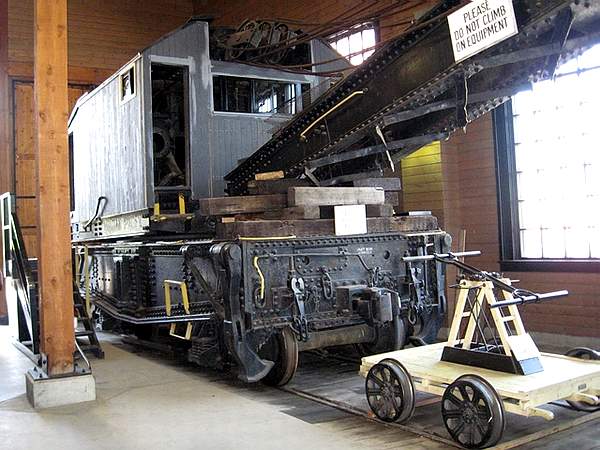 |
The Bucyrus Crane now undergoing restoration in
the Heritage Park Roundhouse on August 2nd, 2014. While Heritage Park has a reputation of rebuilding
In front is one of the operating handcarts owned by
|
| This picture was taken and submitted by Massey F. Jones | |
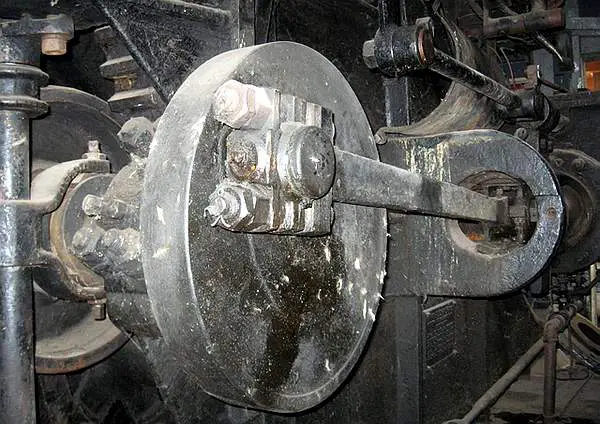 |
Steam from the boiler activated one of these gigantic
pistons linked to an eccentric wheel, which operated the crane pulley system. This one is on the right side and available for view
|
| This picture was taken and submitted by Massey F. Jones | |
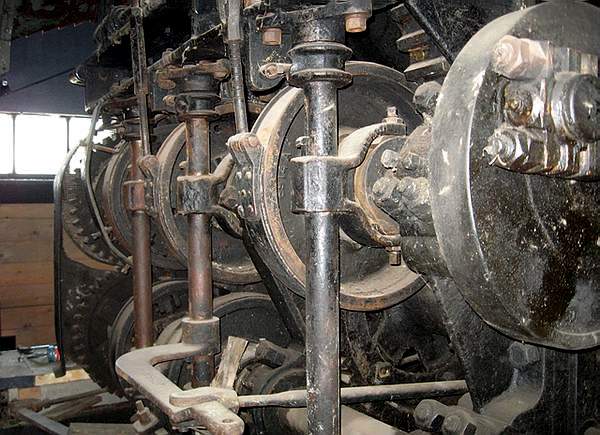 |
The intricate array of gears and other wheels
activating the lifting system of Canadian Pacific 414328, 75-Ton Bucyrus Steam Crane |
| This picture was taken and submitted by Massey F. Jones | |
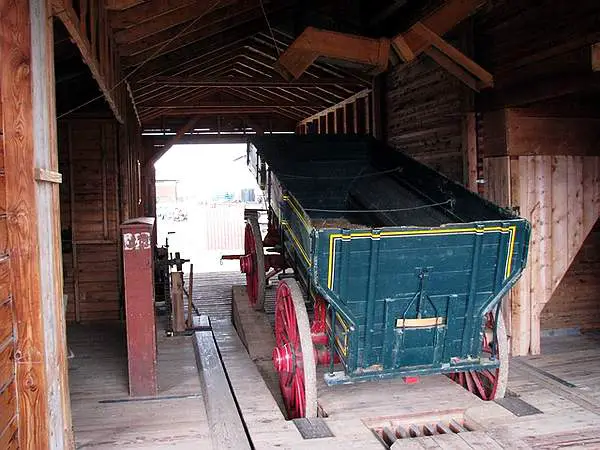 |
Part of the Shonts Elevator display at Heritage Park
in Calgary, showing a horse-drawn wooden grain wagon,
tilted back on the weighing scale for unloading. View the floor grate, which accepts the grain into the augers, where they are then lifted into the proper bins. Everything has been restored to working order.
A brass plaque screwed outside the door states:
|
| This picture was taken and submitted by Massey F. Jones |
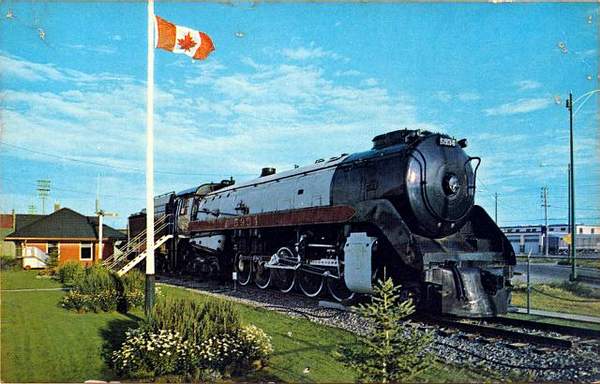 |
CPR Locomotive 5934 was displayed on the outskirts
of downtown Calgary from 1959 to 1991, next to Mewata Stadium, whose high
floodlights can be seen in the background above the building.
The name Mewata is for the nearby armory, which is
The locomotive was subsequently renumbered 5931 and moved. This view looks east and a bit south. |
| Massey F. Jones collection |
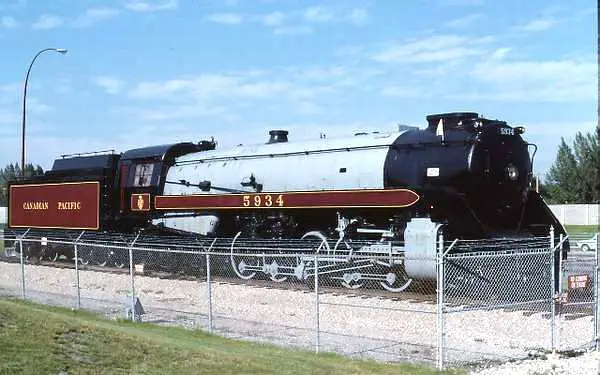 |
The CPR 5934 was displayed at
the entrance of Heritage Park in Calgary for a number of years
CPR 5934 was originally
located at Mewata Park in
|
| This picture was taken and submitted by Massey F. Jones | |
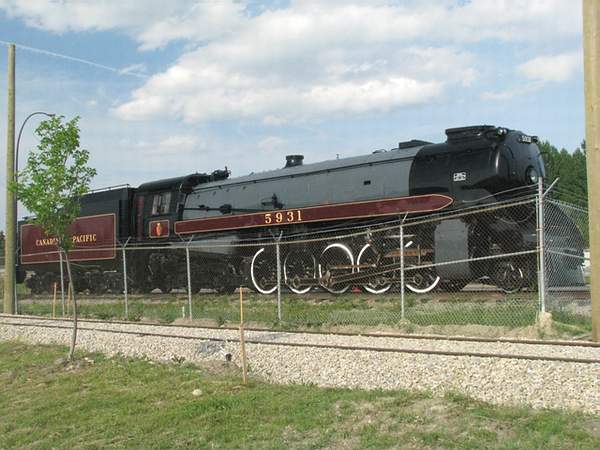 |
CPR 5931 Heritage Park
in Calgary 1991
In 1991, the original number (5931) was reinstated. The track in front was laid in
1990 to accommodate the Heritage Park streetcar, which shuttles visitors
from the parking lot to the main gate during the open season May
|
| This picture was taken and submitted by Massey F. Jones | |
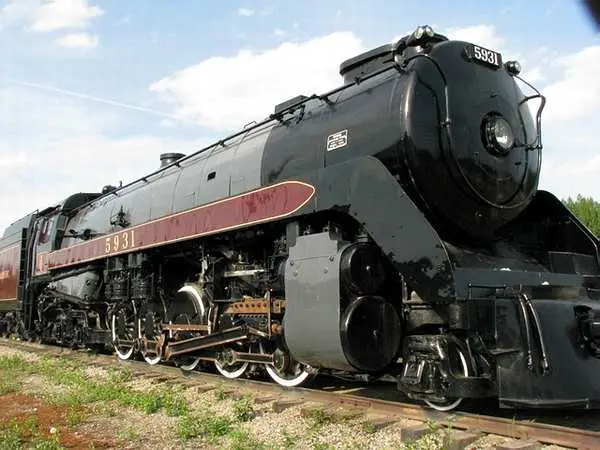 |
Canadian Pacific Railway 2-10-4 Selkirk 5931 at the
entrance of Calgary's Heritage Park, viewed close-op through the security fence. First of all, it's called a 2-10-4 because it has 2 leading wheels, 10 driving wheels and 4 trailing wheels. The name Selkirk comes from where the locomotive was normally operating, the Selkirk Range of the Rocky Mountains in southeastern British Columbia. Notice the rounded shape of the cab. Selkirk locomotives
were specifically designed to operate in mountain tunnels
|
| This picture was taken and submitted by Massey F. Jones | |
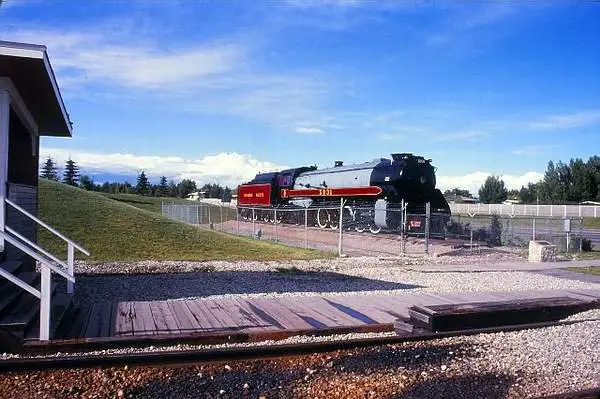 |
When this photo was taken on 19 Dec 1991, the
boardwalk and stairs led to the main gate on the next level, as well as the end of the streetcar track, at Heritage Park in Calgary. Around 2007, with the Heritage Park expansion and construction
of what is now called The Heritage Town Square, the gate was moved back
and the boardwalk
|
| Massey F. Jones collection | |
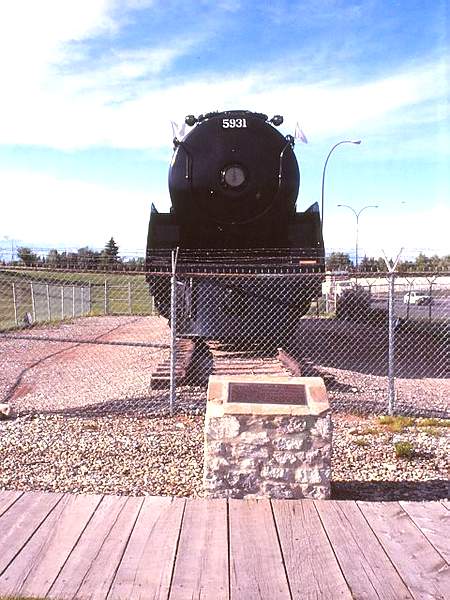 |
In 1991, a commemorative cairn (since removed)
stood in front of the loco. Research has indicated that the plaque probably read as follows: _____________ LAST OF THE 5900s Locomotives of this type were used by the Canadian
They were known as the Selkirks, after one of the
Specifications: Length, 98 feet; Height, 15.5 feet;
|
| Massey F. Jones collection | |
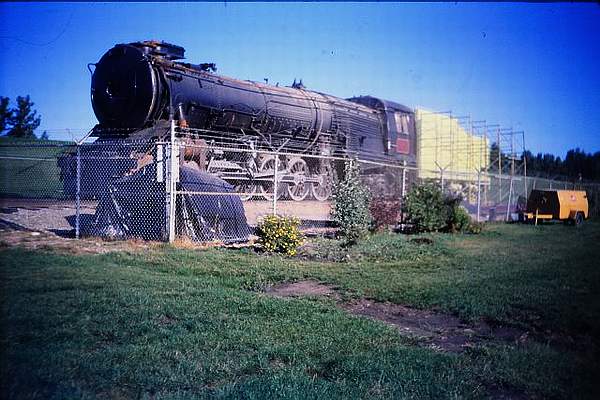 |
This photo, dated October 29th, 1988 shows
locomotive CPR 5931 at the foot of Heritage Park in Calgary; undergoing some sort of operation, most likely repainting. |
| Massey F. Jones collection | |
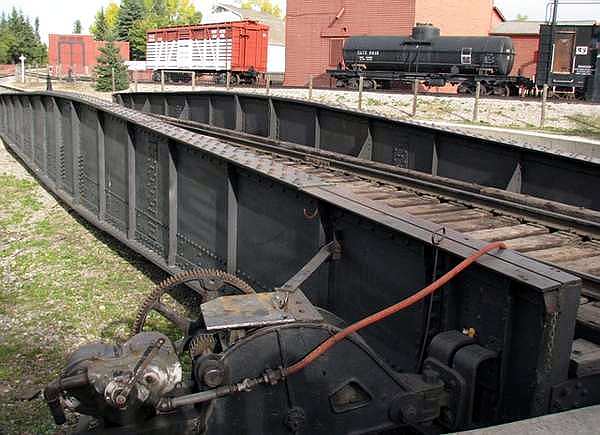 |
One of the key elements of Heritage Park, is the
turntable, allowing it to turn their artifacts around when needed or shunt them to a different location. A turntable is almost always installed in front of a locomotive roundhouse. Its origin is unclear. To the best of the Park's
|
| This picture taken and was submitted by Massey F. Jones | |
|
|
The Heritage Park is air-operated by the red hose
shown
in this picture which is then attached to the locomotive air compressor. A lever then allows the table mechanism to turn at a selected rate. When not in use, the gears are covered. Some non air-operated turntables have been called "Armstrong
turntables" by railway crews, meaning that strong arms were needed to activate
the turntable, by
|
| This picture taken and was submitted by Massey F. Jones | |
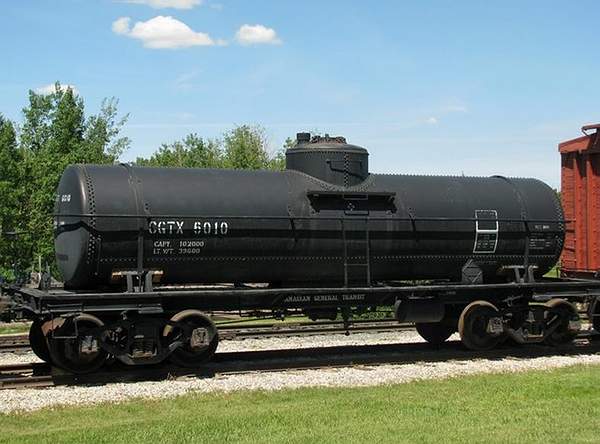 |
Among other artifacts in the Heritage Park collection
is tank car 6010, built in 1935 and formerly owned by The Canadian General Transit (CGTX), who leased them to railways. In 1930, there were 104 different commodities being
|
| This picture taken and was submitted by Massey F. Jones | |
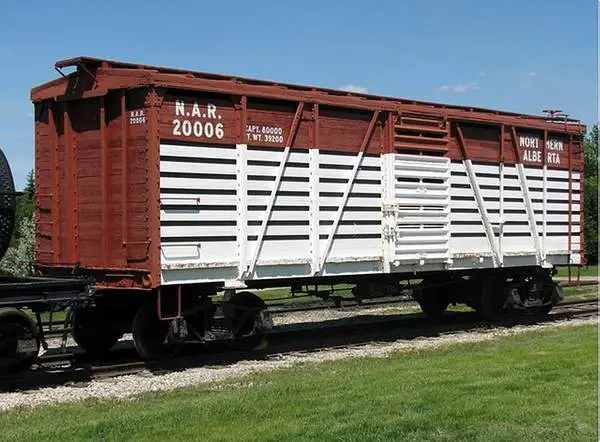 |
Stock Car 20006 in the Heritage Park collection.
The car was built in 1912 by The American Car
|
| This picture taken and was submitted by Massey F. Jones | |
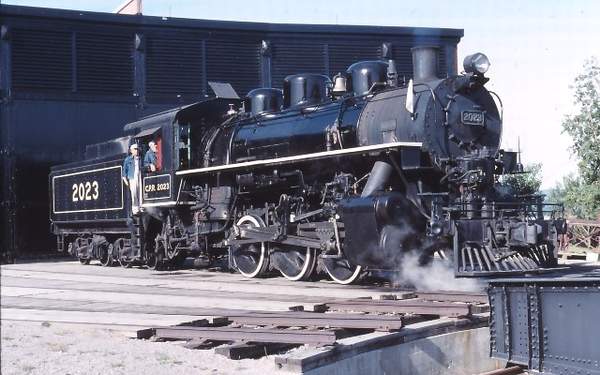 |
CPR 2023 ready to go on the
turntable during Railway
Days, at Calgary's Heritage Park late summer Railway Days is a 2-day celebration of railway operations, telegraphy and exhibition of railway artifacts. CPR 2023 is placed on the 1907 turntable for a public demonstration on how it works, while the other carries on with ticketed passengers, twice around the property for about 45 minutes. |
| This picture taken and was submitted by Massey F. Jones | |
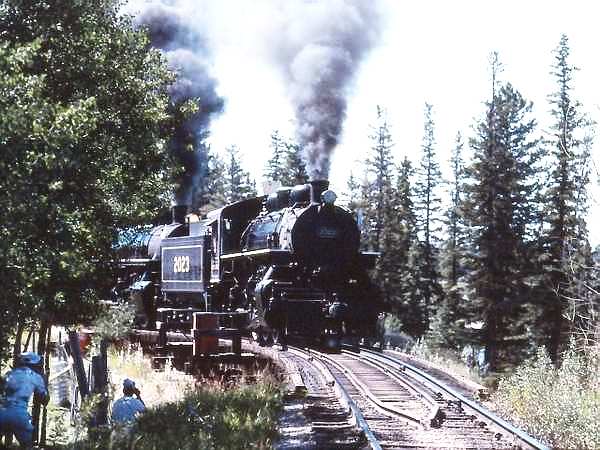 |
Heritage Park CPR 2023 and 2424 double heading over
the only rail bridge on the property, during Railway Days in July 1988. Note the people in the lower left corner who have more than a passing interest. While one engine hauls a passengers around the property, the other one will haul a freight consist. Then they are both are combined as a "mixed train" and run around the property a few times. |
| This picture taken and was submitted by Massey F. Jones | |
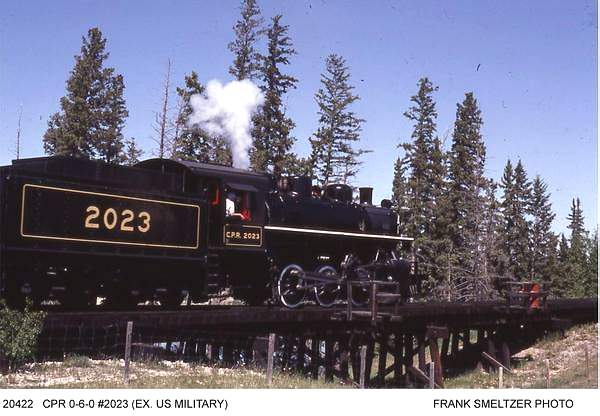 |
CPR 0-6-0 #2023 (Ex US Military)
Heritage Park CPR 2023 going over the only rail bridge
|
| This picture was submitted by Jim Parker and is part of the Frank Smeltzer Collection | |
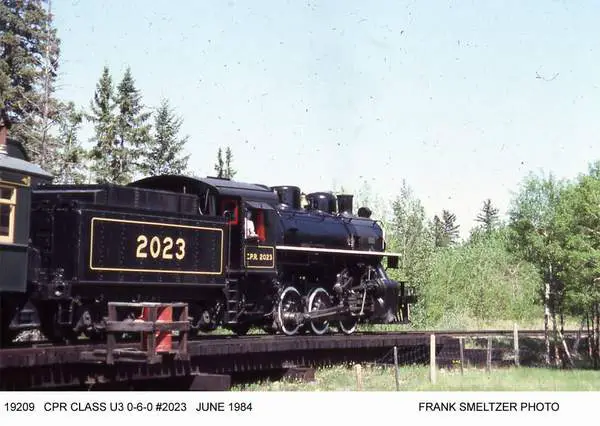 |
CPR Class U3 0-6-0 #2023 June 1984
Heritage Park CPR 2023 going over the only rail bridge
|
| This picture was submitted by Jim Parker and is part of the Frank Smeltzer Collection | |
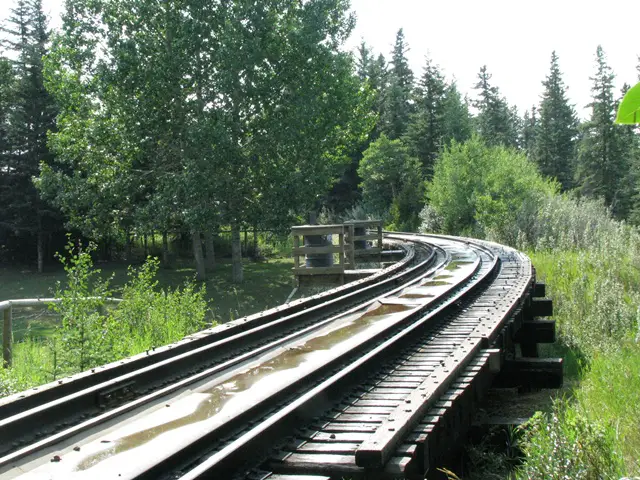 |
The only trestle in Calgary's Heritage Park,
designed
for drainage, instead of using a culvert. Trestles are custom built to fit the scenery. This one was erected in 1973 as a gift from the Canadian Pacific Railway. The water barrels on the left side of the trestle are for fire fighting, in case the locomotive should accidentally drop cinders on the trestle. |
| This picture taken and was submitted by Massey F. Jones | |
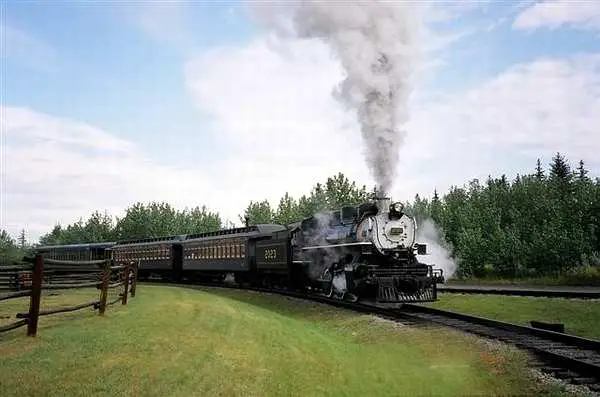 |
Locomotive 2023 brought out early morning for a special
function in 2005.
The normal Heritage Park train consist is composed
of either 2023 or 2024 and passenger cars Morrissey,
To prevent excessive rail wear, the train runs clockwise
Michel, now a ghost town, was once a thriving community
|
| This picture taken and was submitted by Massey F. Jones | |
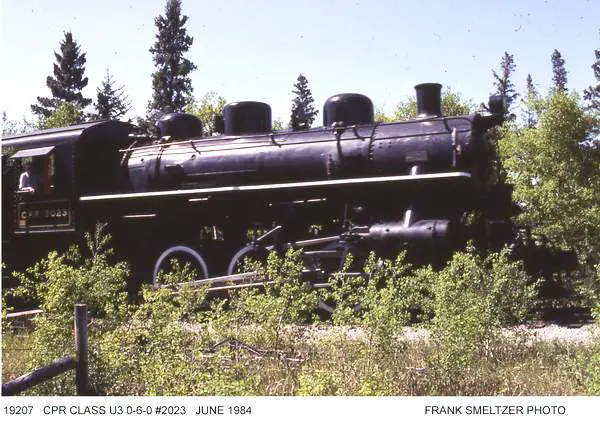 |
CPR Class U3 0-6-0 #2023 June 1984 |
| This picture was submitted by Jim Parker and is part of the Frank Smeltzer Collection | |
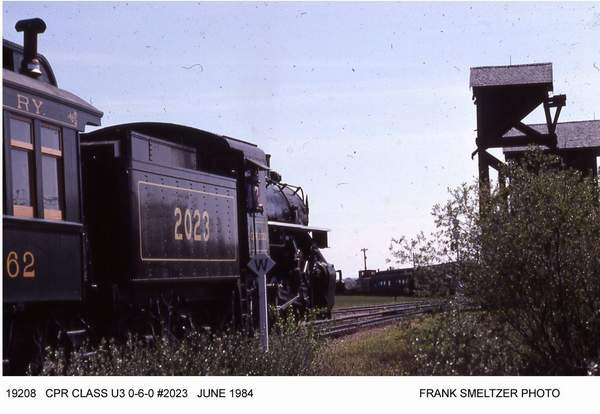 |
CPR Class U3 0-6-0 #2023 June 1984 |
| This picture was submitted by Jim Parker and is part of the Frank Smeltzer Collection | |
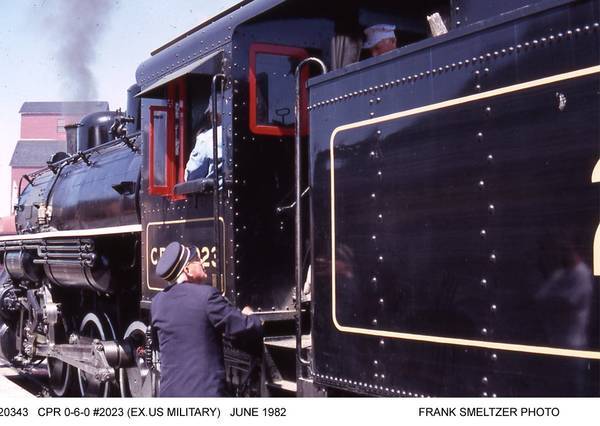 |
CPR 0-6-0 #2023 (Ex US Military) June 1987S |
| This picture was submitted by Jim Parker and is part of the Frank Smeltzer Collection | |
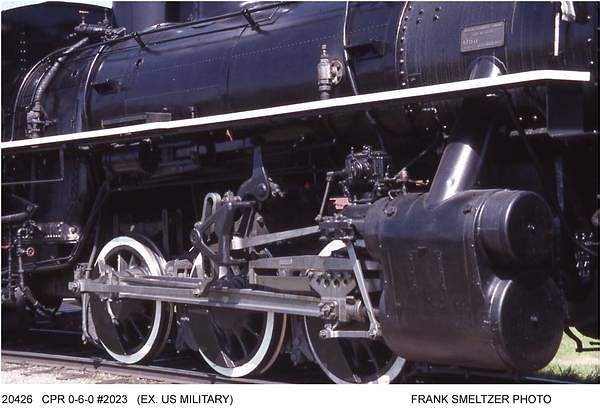 |
CPR 0-6-0 #2023 (Ex US Military) June 1987 |
| This picture was submitted by Jim Parker and is part of the Frank Smeltzer Collection | |
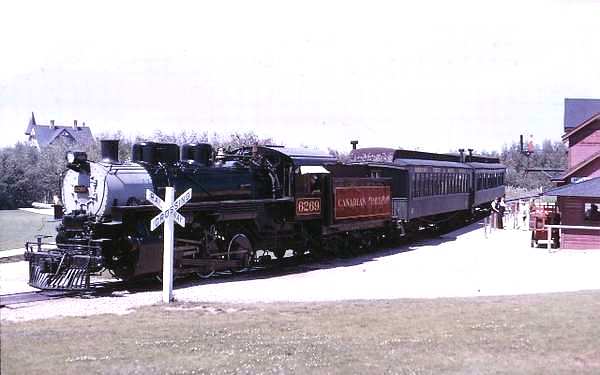 |
Here's a CPR locomotive that's
never been on CPR
tracks, except perhaps to be transported. "CPR 6269" Lima-built 0-6-0 locomotive started life in 1944 and joined the US Army in 1946 as their 4076, before coming to the Pacific Coast terminals in 1964, then to a private owner in December 1967 and finally to Calgary's Heritage Park that year. The Park ran her as "CPR 6269" from 1967 to 1969, before repainting her to her current "CPR 2024", along with sister "CPR 2023" , an ALCO 0-6-0 locomotive with about the same Army and civilian history but built two years earlier in 1942. |
| Photo: L. Unwin Collection Massey F. Jones | |
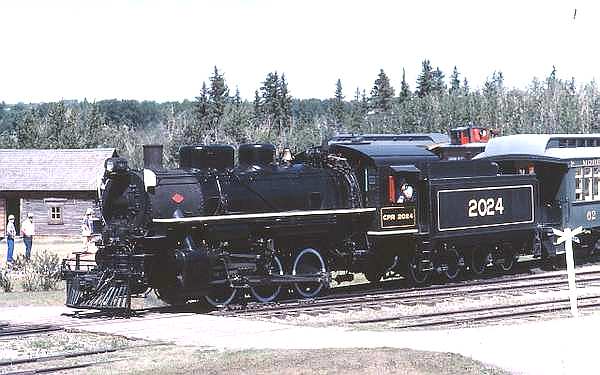 |
Heritage Park operates either
2023 or 2024 daily and at very frequent intervals around a circular
the property.
A train ride consists of 2 laps with several stops at various stations to pick up passengers. All Heritage Park staff wears period costume. Once a year in late summer on "Railway Days", a two-day event, Heritage Park double-heads 2023 and 2024 and runs a mixed consist of freight and passenger. Either 2023 or 2024 is then brought to the roundhouse, placed on a turntable and the practice is demonstated.http://www.heritagepark.ca/specialevents.htm |
| Photo: L. Unwin Collection Massey F. Jones | |
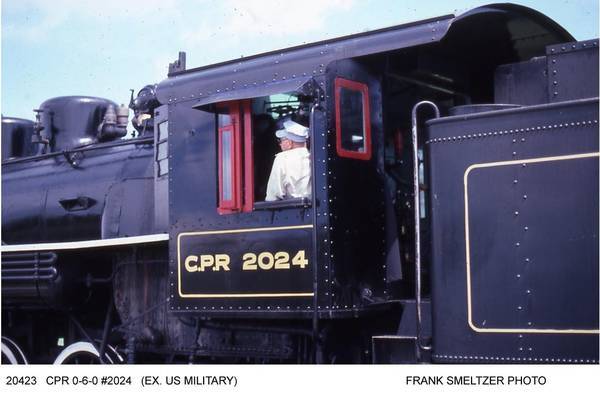 |
CPR 0-6-0 #2024 (Ex US Military) June 1987 |
| This picture was submitted by Jim Parker and is part of the Frank Smeltzer Collection | |
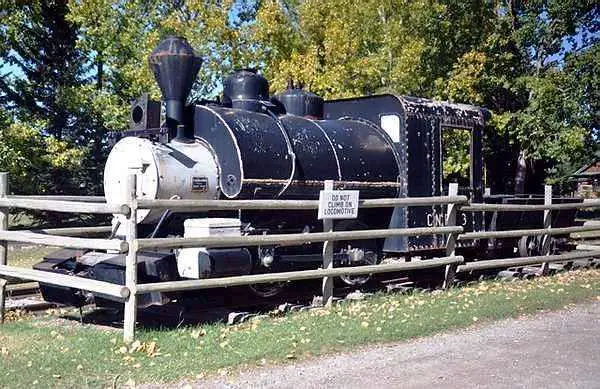 |
Tucked into a quiet area of Heritage Park behind
Laggan Station, is Crowsnest Pass Coal 3, a saddletank locomotive, formerly used for hauling coal out of the mine to the tipple for washing. The term "saddletank" refers to the fact that the water tank straddles the boiler, saving space, since the loco doesn't require a tender. CNP 3 is a 42''gauge 0-4-0T built by Vulcan Iron Works of Wilkes-Barre Pennsylvania in December 1902. Vulcan Iron Works was a builder of small mine locomotives but not as big as its competitor, Porter, and it closed down in 1950. For obvious reasons - fire and smoke are bad in a coal
|
| This picture taken and was submitted by Massey F. Jones | |
 |
The engineer's side of the locomotive. For many years,
the display wasn't fenced. A sign on the other side now tries to prevent further deterioration of this historical artifact. View a photo of the locomotive when it wasn't fenced at: http://trains.nute.ws/0-4-0/CNP3.htm At that time, the loco was also in a far more pristine condition. Like other Heritage Park artifacts, it may be someday restored, but not to operating condition. |
| This picture taken and was submitted by Massey F. Jones | |
 |
A string of small wooden cars inside the mine, were
brought to the surface by "Thermos bottle", high pressure steam or air locomotives (600-800psi) that could be recharged at various stations in the mine and looked like a large water tank, laid down on rail wheels. Most of these underground locomotives were built by HK Porter. Beingfireless, those did not represent a danger. With no operator cab due to cramped conditions, they simply pushed the load up an incline to the surface, where CNP 3 took over. When the rickety coal cars became too worn out, they
The track in front is part of a wye, used to back up
a locomotive to the square water tank shown elsewhere,
|
| This picture taken and was submitted by Massey F. Jones | |
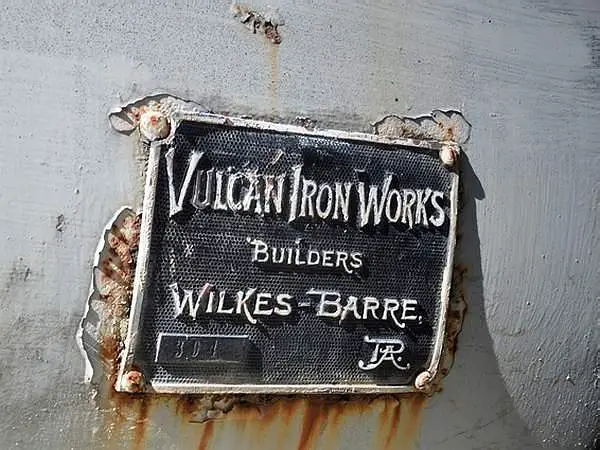 |
The ornate plaque, showing the construction number
on the boiler of 0-4-0T mine locomotive CNP 3 at Heritage Park. The Crowsnest Pass Coal Company operated in the
|
| This picture taken and was submitted by Massey F. Jones | |
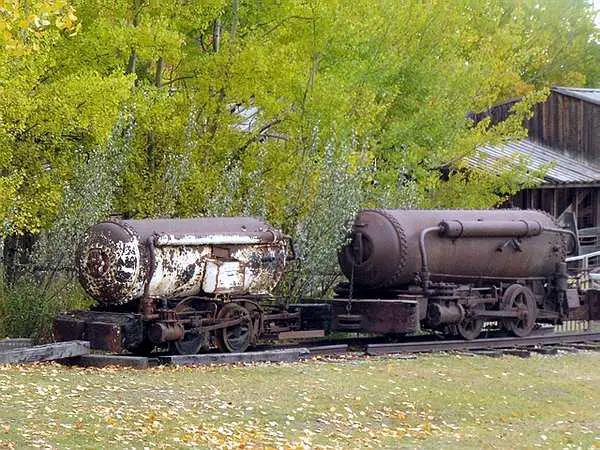 |
These two are two Compressed Air mine locomotives,
displayed the Natural Resource area of Heritage Park. The six-ton locomotive in front was used in Canmore
for
Both units were built by the H.K. Porter Company Ltd,
Being fireless, compressed air locomotives were used
|
| This picture taken and was submitted by Massey F. Jones | |
.jpg) |
These 3 flatcars, yet to be restored are one of two
displays on a side track in the "Railway Section" of Heritage Park. Left to right: CPR 306684 (aka OY22),
|
| This picture taken and was submitted by Massey F. Jones | |
.jpg) |
Of the 3 flatcars, the most interesting is CPR 311386,
which has a set of Can-Car trucks as a load. |
| This picture taken and was submitted by Massey F. Jones | |
.jpg) |
Morrissey Fernie & Michel Railway flatcar 53,
coupled here on exhibition the rear of Heritage Park snowplow CP 400884. MF&F was a holding company catering to the CPR
In addition, free passenger trains operated several
|
| This picture taken and was submitted by Massey F. Jones | |
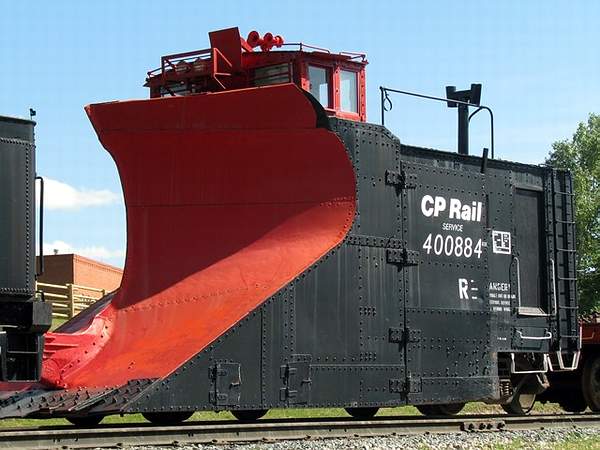 |
Snowplow CP 400884, on a siding at Heritage Park on
July 1st, 2014, coupled between CP Tender 415722 and Morrissey Fernie & Michel Ry #53, shown elsewhere on this page. While today's road locomotives have a small plow in
At the very bottom of the plow is a blade or "tongue",
While it looks simple, the plowman must be familiar
The original number for the Heritage Park snowplow
was 300884 when manufactured in December 1911 and it
|
| This picture taken and was submitted by Massey F. Jones | |
.jpg) |
The rear of Snowplow 400884, built in December 1911
at the Canadian Pacific Angus Shops, in the East End Montreal Rosemont district (a blue collar area). http://members.kos.net/sdgagnon/ang.html . Angus shops were the main repair shop for Eastern Canada and lasted about a century, before being decommissioned in 1992 and the land redeveloped into housing and parks. Some of the buildings re-purposed. http://www.cmhc-schl.gc.ca/en/inpr/su/sucopl/upload /Angus-Montreal-Quebec.pdf Both sides have extendable wings and you can see the
|
| This picture taken and was submitted by Massey F. Jones | |
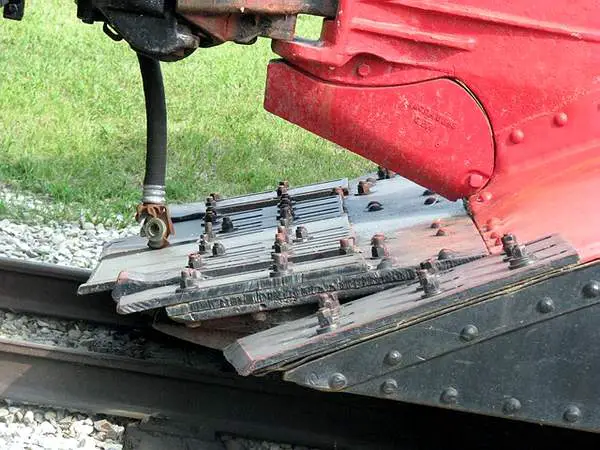 |
Detail from wedge Canadian Pacific plow 400884 at
Heritage Park. The centre portion is adjustable and the operator must
ensure that it clears the ties, turnouts (switches) and
Snow is lifted by the blades and pushed into the wedge,
This type of plow is used for single track only. Double
|
| This picture taken and was submitted by Massey F. Jones | |
.jpg) |
Canadian Pacific Tender 415722 was built in 1907 by
the Richmond Locomotive and Machine Works of Richmond, Virginia in 1907
to be matched to Canadian Pacific D-10 Class, 4-6-0 locomotive No. 613
http://members.shaw.ca/cprsteam/d10a-d10k.htm
The tender gets periodically switched around
|
| This picture taken and was submitted by Massey F. Jones | |
.jpg) |
CP Tender 415722 coupled to CP now Plow 404884 and
CGTX Tank Car 6010 on a siding at Heritage Park on
July 1st 2014. Heritage Park likes to restore their railway artifacts
in pristine condition, as good or better than when they
The track in front is their "Mainline" |
| This picture taken and was submitted by Massey F. Jones | |
.jpg) |
One of the best kept secrets of Heritage Park is
"Lil" Pat, brought out occasionally to shunt cars around various buildings, instead of using their dieselized steam engine 2018. The loco is seen in these views in front of the Heritage Park Car Shop. "Lil" Pat is a 20-ton yard switcher and a builder's
|
| This picture taken and was submitted by Massey F. Jones | |
.jpg) |
Whitcomb started production around 1906. In the
beginning, the company only produced locomotives up to 10 tons, for use in mining operations (Some possibly replacing steam locos, such as the CNP 3 shown on this page, outside the mine shaft). In 1930, the company filed for bankruptcy and was taken over by the Baldwin Locomotive Works, which owned a majority of Whitcomb stock. It still operated as the Whitcomb Locomotive Works; until in 1940, when itbecame a division of Baldwin, producing hundreds of the US government for use in Europe and the US during WWII. Many of these little giants operated on dockyards and into munitions factories, shunting cars many times their own weight. View a Baldwin poster, promoting their Whitcomb line, at: http://en.wikipedia.org/wiki/File:WWII_print_ advertisement_for_Baldwin_Little_Giants.jpg |
| This picture taken and was submitted by Massey F. Jones | |
.jpg) |
Following WWII, many of these little locos were
sold to mine and gravel pit operators and to others who demanded a reliable and rugged locomotive that would go on and on at low cost, to the point of extreme abuse and still run. While many still employ Whitcomb locos today (mostly around tourist operations), most industries are now using the more versatile "Trackmobile", which can operate on off railway tracks. View one in action at: http://www.youtube.com/watch?v=IUAeFzGbt4U Whitcomb industrial locomotives ranged, from
|
| This picture taken and was submitted by Massey F. Jones | |
.jpg) |
"Lil" Pat and CP 2018 displayed in front of the
Car Shop. On the extreme left, Heritage Park staff give
In the very back, Construction Car 76, built in 1882
|
| This picture taken and was submitted by Massey F. Jones | |
.jpg) |
There isn’t much to the cab of a 20-ton Whitcomb .
The basic controls are shown here. To the left is a large vertical 900 L or so (about 200 imp gal) fuel tank, a fire extinguisher and a toolbox. Operating the Whitcomb is one-man job. |
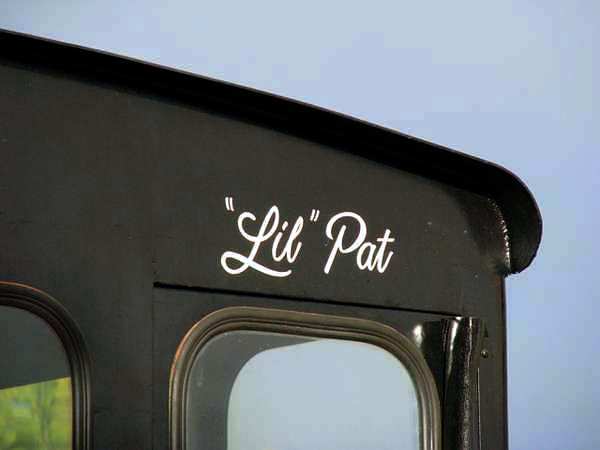 |
A lot of owners liked to call their little giants
"Li'l something"and this one is no exception. The following is from Brian Manning
"Lil Pat was donated to Heritage Park by Orica in
|
| This picture taken and was submitted by Massey F. Jones | |
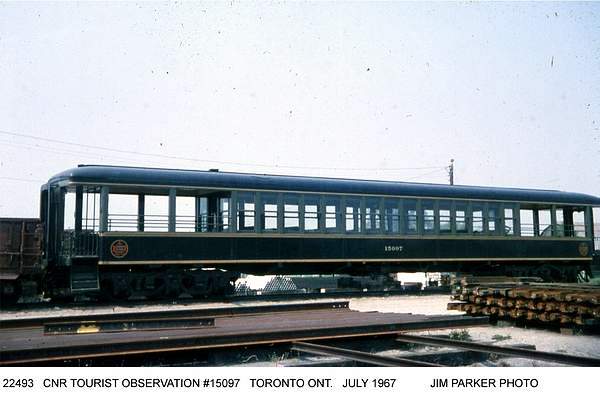 |
CNR Tourist Observation Car #15097 at Toronto Ont.
July 1967 This car was built in 1892 and is now at Calgary's
Heritage Park and in daily operation during their open season,
|
| This picture was taken and submitted by Jim Parker | |
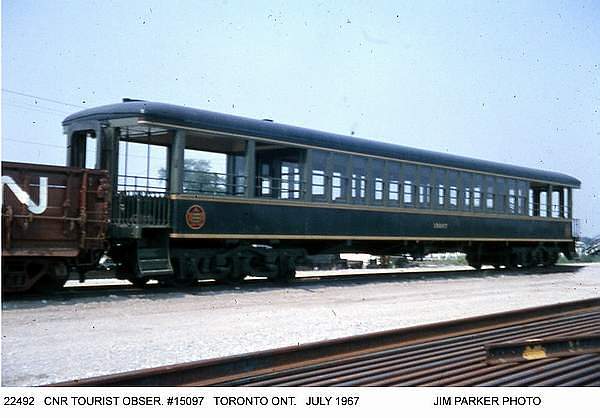 |
CNR Tourist Observation Car #15097 at Toronto Ont.
July 1967 This car was bui;t in 1892 and is now at Calgary's
Heritage Park and in daily operation during their open season,
|
| This picture was taken and submitted by Jim Parker | |
.jpg) |
The interior of CN 15097 Open Observation Car.
Most Heritage Park visitors prefer to ride in the rear section.
Sharp eyes will notice that the leather seats are also reversible, depending upon the choice of facing for the trip by the passenger or train direction. A video posted by Massey at: http://www.youtube.com/watch?v=GRPHKvYIbWA
takes
|
| This picture taken and was submitted by Massey F. Jones | |
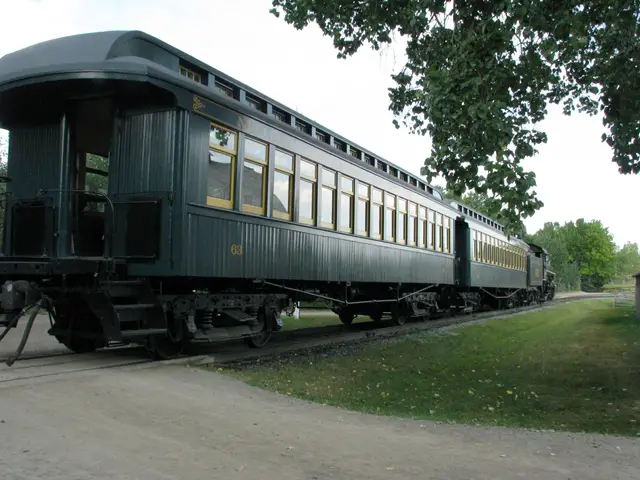 |
Morrissey Fernie &Michel Coaches 62 and 63 behind
locomotive CPR 2024, at the end of the day's run
Missing is Observation Car CN 15097 (shown on this page), now uncoupled. The train is about to be wyed on a track to the left and backed up to the rectangular enclosed water tower seen elsewhere on this page MF&M 63 is at the rear. MF&M 63 was built in 1902 and MF&M 62
dated from 1885. Morrissey Fernie & Michel Railway served a mine
|
| This picture taken and was submitted by Massey F. Jones | |
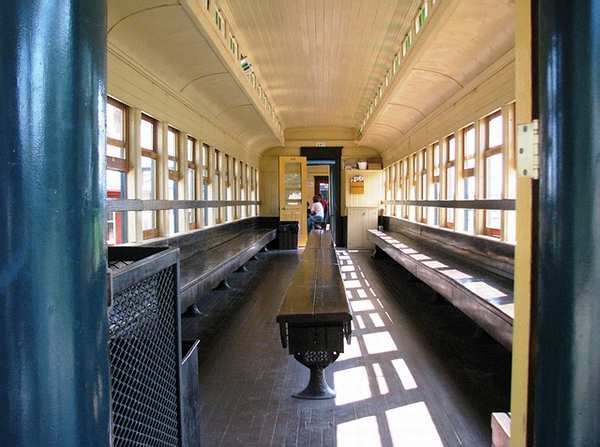 |
The interior of Morrissey Fernie & Michel
63.
One word describe the comfort: functional. |
| This picture taken and was submitted by Massey F. Jones | |
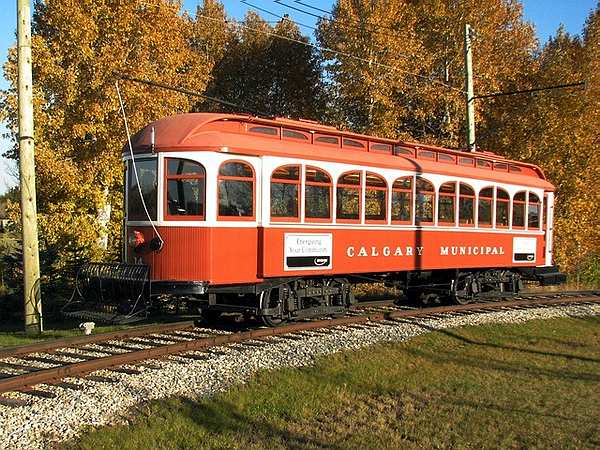 |
Calgary Municipal No 14, more familiarly called the
Heritage Park Streetcar and formally known as The ENMAX Electric Streetcar System; heading home empty on the last trip of the season, October 14th 2013 around 5:00 pm. Car 14 was the very last streetcar to run in Calgary,
More streetcar parts were found and donated to
|
| This picture taken and was submitted by Massey F. Jones | |
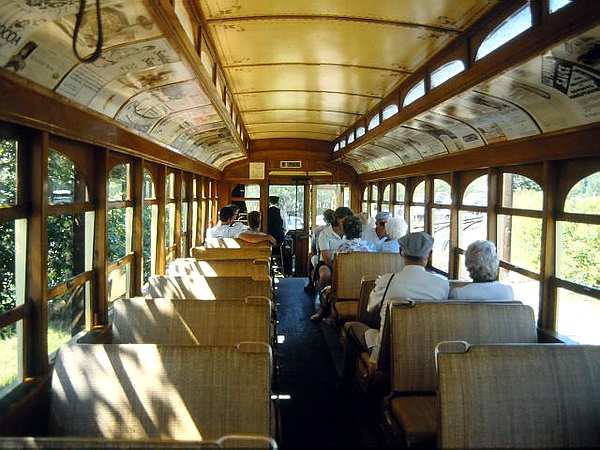 |
The interior of Heritage Park #14 or #15. The streetcars
are mostly alike inside and outside and used alternately. Streetcar operation is daily during June, July and August but weekends only at the beginning and end of the visitor season. More details and a 15-minute technical video of No 15 in action at: http://www.youtube.com/watch?v=mIF0QlU99uU |
| This picture taken and was submitted by Massey F. Jones | |
|
|
The double-door setup of Heritage Park cars 14 and
15,
also called by some “a Prairie Style Door”. The other side at the back is identical. Thomas Henry McCauley, superintendent of the Calgary
electric streetcar railway, from the beginning in 1909 to
The door mechanism patent was filed on 5 June 1917
The Patent also made its way to the States as US 1249976
http://www.google.com/patents/US1249976
|
| This picture taken and was submitted by Massey F. Jones | |
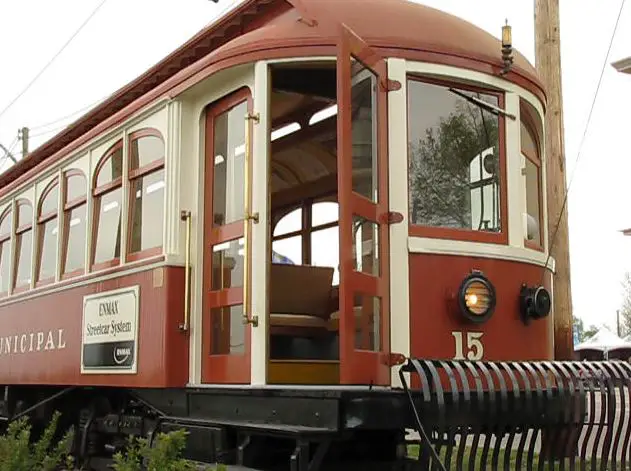 |
Car #15 with the door open |
| This picture was submitted by Massey F. Jones | |
| Specification of Letters Patent. Patented Dec. 11,
1917 Application filed February 28, y1917. Serial No. 151,475.v
To all whom it may concern. Be it known that I, THOMAS HENRY MCCAULEY, a citizen
of the Dominion of Canada and subject of England, residing at Calgary,
in the Province of Alberta and Dominion of Canada, have invented new and
The present invention relates to street car doors,
and aims to provide a
The present invention also enables ordinary short vestibule single entrance cars to be converted into the double door construction, or to be equipped with the entrance and exit doors at one end in a compact arrangement. Another object of the invention is the provision of
novel means for
It is also within the scope of the invention to provide
the aforesaid improvements,
Of note in these pictures is the large “cowcatcher”,
prominent in these
|
This is an extract from the patent for the "Prairie"
style
door on early Calgary Transit streetcars. (some typos corrected for the purpose of this caption) |
| Massey F. Jones | |
|
|
The controls on Car #15 |
| This picture was submitted by Massey F. Jones | |
|
|
The controler on Car #15 |
| This picture was submitted by Massey F. Jones | |
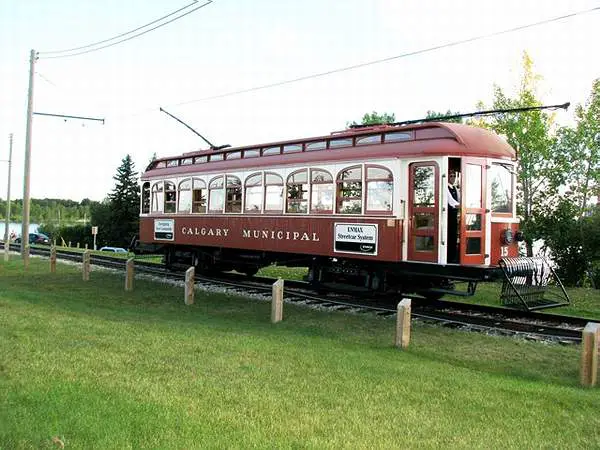 |
Car #15, arriving back to the main Heritage Park main
gate, after ferrying passengers to and from their car in the parking lot. The uniformed conductor is just opening the Prairie-style door, locally invented by Calgary Electric Superintendent McCauley and getting ready to off-load passengers at ANDREW station, by the main gate within a minute or two. Car #15, built in the Heritage Park shops, is
a replica
|
| This picture was submitted by Massey F. Jones | |
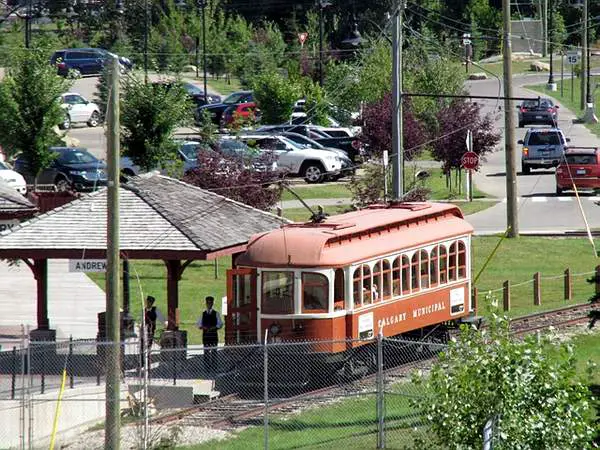 |
The conductor and the motorman are waiting for the
last passengers at ANDREW station by the main gate. before Calgary Electric Car #15 departs for the parking lot through about one kilometer of track which takes about 10 minutes end-to-end with all the proper sounds and ride. There is a station at either end and one about the middle and they are named for a major donor. To mark its 50th Anniversary season, unlimited rides
This telephoto shot is taken from a hill accessible
|
| This picture was submitted by Massey F. Jones | |
 |
CPR Car #141 was constructed in Montreal in 1907 to
serve on suburban duty, probably to the West Island, an area served today by modern trains, just past P-E Trudeau airport (YUL). The reversible rattan seats can be oriented for the direction of travel once the train reached its destination, without need to turn the car around. It’s next assignment was as part of a ski train, which
In 1951, the car was withdrawn from passenger service
|
| This picture was taken and submitted by Massey F. Jones | |
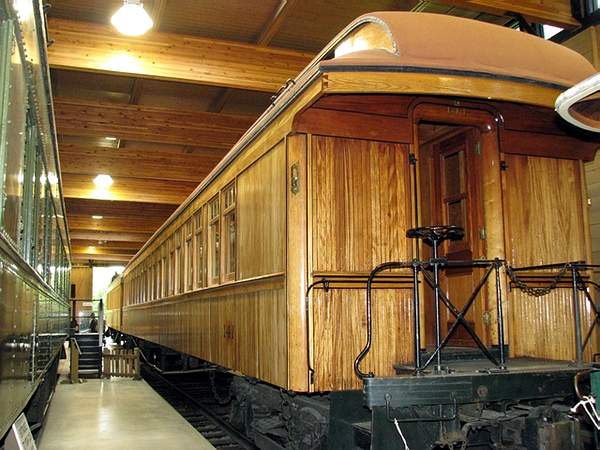 |
Fate intervened in the mid-1970s when an older railcar
car couldn’t be used for the filming of the 8-part series "The National Dream" and DAR 411585 became required as a stand-in. The exterior was then restored at the Weston Shops in Winnipeg to resemble a passenger car of the 1880s and renumbered to 141. Fate intervened in the mid-1970s when an older railcar car couldn’t be used for the filming of the 8-part series “The National Dream” and DAR 411585 became required as a stand-in. The exterior was then restored at the Weston Shops in Winnipeg to resemble a passenger car of the 1880s and renumbered to 141. http://www.dardpi.ca/wiki/index.php?title=File:141.jpg After the TV series which ran in 1974, CPR ran a display train, to complement their “CP Bygone” store at Windsor Station in Montreal where surplus artifacts could be procured, such as railway dinnerware and CPR Beaver heralds formerly used on their passenger cars.. In addition to showcasing the CPR history to the public, it made acquisition of some artifacts possible. The train toured Canada, with a business car at the end for the crew.
|
| This picture was taken and submitted by Massey F. Jones | |
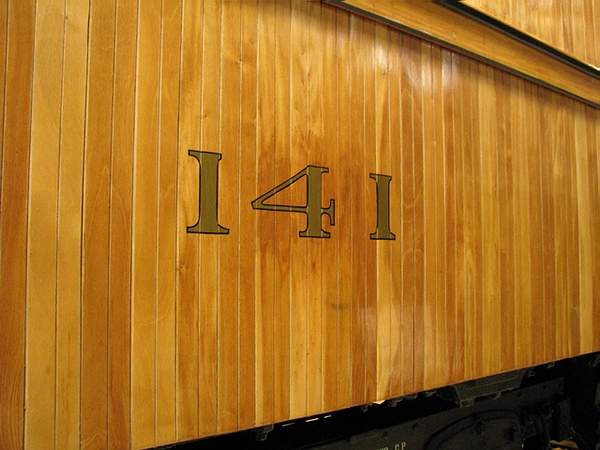 |
The information board on the Car # 141 platform,
mentions that Car #141 was used at one time, transporting passengers between Winnipeg and Winnipeg Beach; about 45 minutes north of Winnipeg on the shores of Lake Winnipeg. It was probably its last assignment, before being decommissioned by the CPR |
| This picture was taken and submitted by Massey F. Jones | |
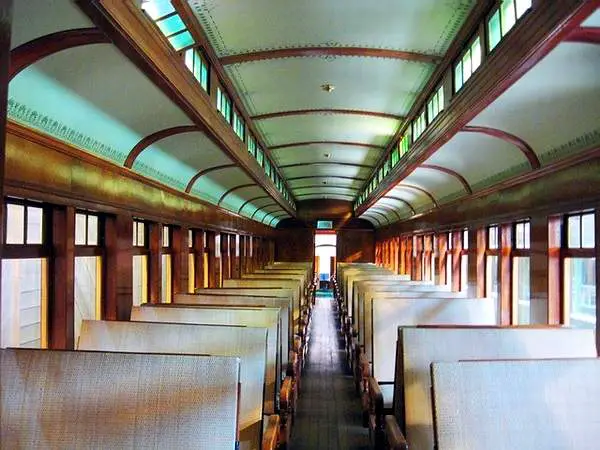 |
In 1980, it was acquired by Heritage Park who
refinished it to its present state. In 1989, following restoration Car #141 won the annual Canadian Railroad Historical Association "Preservation Award". Car # 141 is the last varnished mahogany railcar
|
| This picture was taken and submitted by Massey F. Jones | |
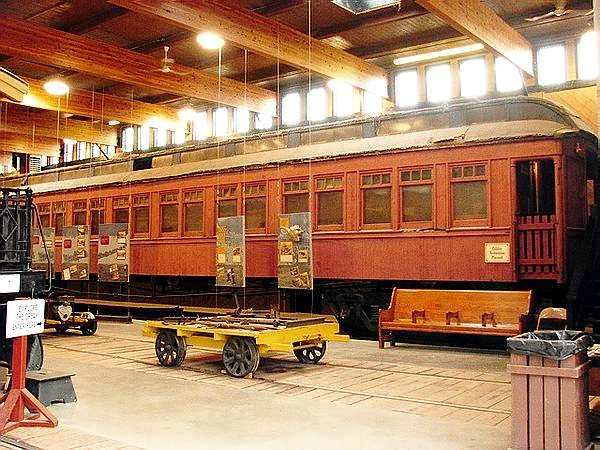 |
In the early 1900s, Canadian Pacific Railway agents
were aggressively recruiting applicants, home and abroad, to help develop Western Canada. Overseas immigrants were sold a package which included a combination of CP ship travel and passage on a CP train, leaving either from Halifax (Pier 21) Quebec City or Montreal. CPR also sold them land at $2.50 and up an acre that required cultivation once they arrived at destination. Higher amounts featured a basic house on the premises. "Colonists" paid only $7.00 in passage from
For others leaving from Eastern Canada, railway
|
| This picture was taken and submitted by Massey F. Jones | |
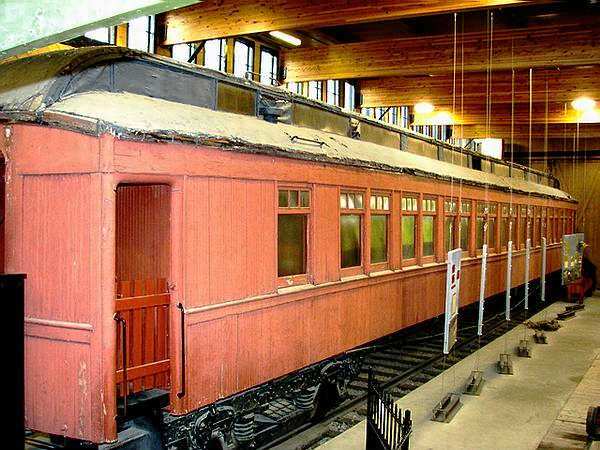 |
A few of the colonist cars had served as troop sleepers
during WWI and a few continued their life by being upgraded for troop travel during WWII. Car 2658 in Calgary's Heritage Park, built in 1912
is
This view in September 2013, of the Ladies' end of
|
| This picture was taken and submitted by Massey F. Jones | |
 |
The "Men Only" smoking section of Colonist Car
2658. Women were not allowed there because, until 1929 in Canada, they were not considered "Persons" and therefore were confined to the rear, with their children. These upholstered seats were about the only comforts
|
| This picture was taken and submitted by Massey F. Jones | |
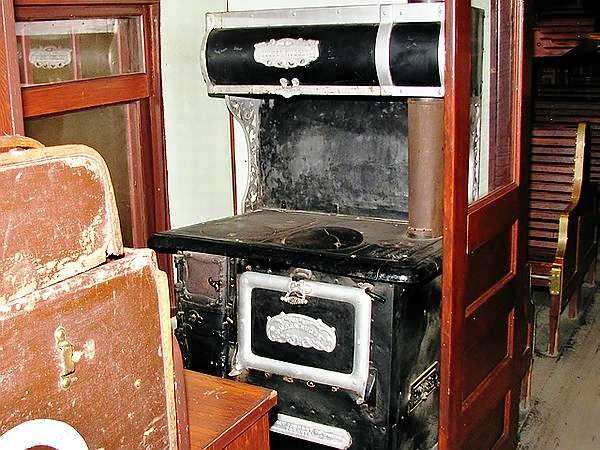 |
Each family was given one hour to prepare a meal for
themselves. Children were notallowed off the train,
lest they wander off and get left behind. This "Golden Nugget" wood stove, manufactured by
|
| This picture was taken and submitted by Massey F. Jones | |
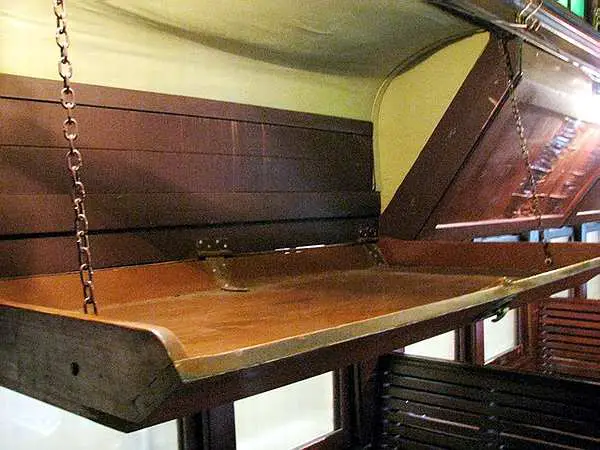 |
Cars such as CPR 2858 slept 72 people in 18 sections
(4 per section). A board was placed between the two lower seats, so that it could sleep 2 people at night, while two more people were expected to occupy the upper berth. No mattress was provided but CPR would sell one
|
| This picture was taken and submitted by Massey F. Jones | |
 |
Replica of a coupon, given by the conductor for
re-boarding Section 6, Car 9125 of Train 91 between Montreal and Calgary, leaving at 5:40 pm Standard Time Aug 27, 1910 and only valid with ticket 60964 . If they so desire, Colonist car 2568 visitors can
|
| This picture was taken and submitted by Massey F. Jones |
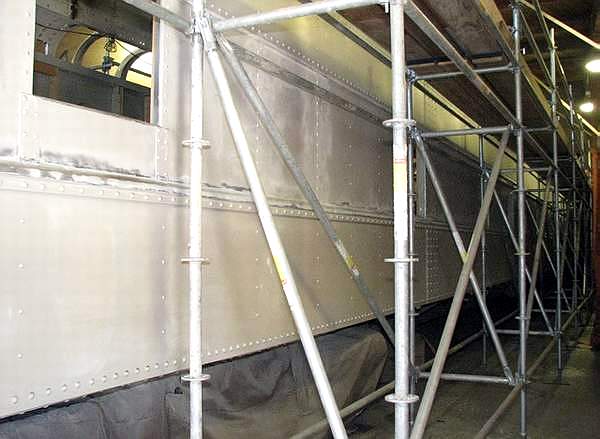 |
Canadian Pacific "Heavyweight" passenger car
RIVER FORTH undergoing re-construction in the roundhouse at Heritage Park in Calgary. Heritage Park purchased it from the CPR without wheels but in apparent good condition. Formerly an elegant Solarium Observation Car it ended its working days as a bare-boned work car, left to decay in the rail yard south of Calgary. RIVER FORTH was built in 1929 for the "The Trans
The Great Depression of the 1930s saw all but 4
|
| Photo: Massey F. Jones, courtesy Heritage Park | |
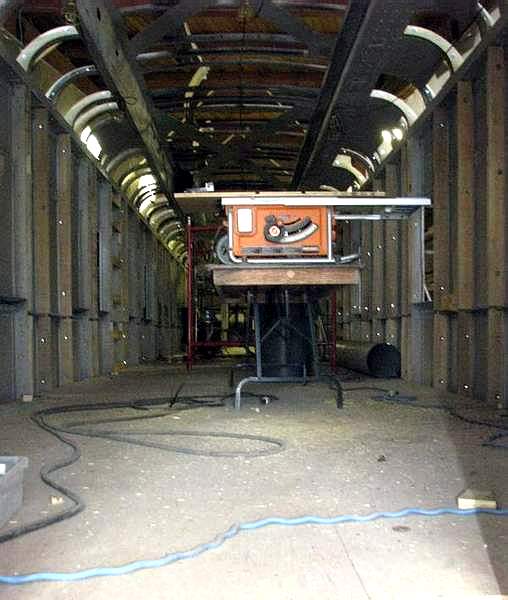 |
With the car completely gutted and stripped, CPR
"RIVER FORTH" is undergoing an extensive transformation in closed off area of the Heritage Park roundhouse. CPR's Solarium-Lounge Car came to Heritage Park
When rolled out again, the car will be used for special
|
| Photo: Massey F. Jones, courtesy Heritage Park | |
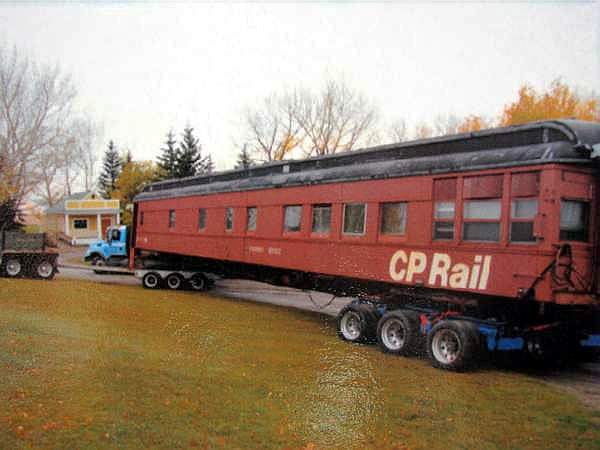 |
Heritage Park posted these 3 photos on the wall in
its
roundhouse, to give the general public an idea of what CPR "RIVER FORTH" looked like upon arrival at Heritage Park and what it will look like after the work is complete. The photos are just a general concept for now but
When completed, the car will be rolled out for fine
Funds raised through the rental of the dining car will
be
|
| Photo: Massey F. Jones, courtesy Heritage Park | |
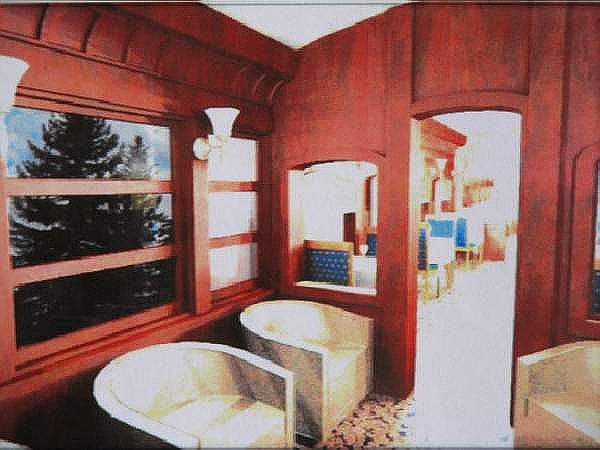 |
The solarium portion of the car to the tail end of
the train
will provide guests with a relaxing place to lounge around, while on Heritage Park track. In the original car, nothing was spared to make this section attractive and the tall windows in that section were covered with "vita glass", which was said to have special health benefits; containing quartz for transmitting the ultraviolet rays of sunlight; the refined chemistry of "vita glass" promising to 'let health into an area' that ordinary s oda-lime glass blocked, hence people flocked to the solarium (sun) car to avail themselves of that healthy benefit. |
| Photo: Massey F. Jones, courtesy Heritage Park | |
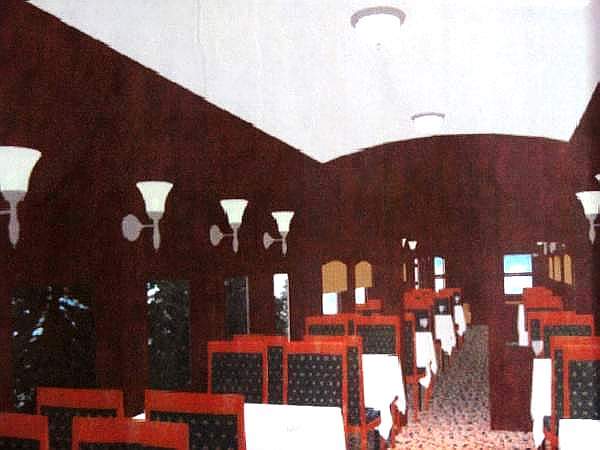 |
Solarium cars were constructed for the comfort of
long distance passengers and, while there was a dining car
on the train providing full meals, sales from the buffet in this car generated extra revenue for the railway. Fine dining is the main purpose of this section and
|
| Photo: Massey F. Jones, courtesy Heritage Park |
Links to the other areas of Canada
 |
 |
 |
 |
|
|
|
|
|
Two site worth looking at.
The
Memory Lane Railway Museum in Middleton, Nova Scotia.
The
only exclusive Dominion Atlantic Railway museum in the world
Welcome
to the DAR DPI
A web
community initiative intent on digitally preserving
the history
of the Dominion Atlantic Railway
| Privacy Policy for http://yourrailwaypictures.com/
If you require any more information or have any questions about our privacy policy, please feel free to contact us by email at john@summervillens.ca At http://yourrailwaypictures.com/, the privacy of our visitors is of extreme importance to us. This privacy policy document outlines the types of personal information is received and collected by http://yourrailwaypictures.com/ and how it is used. Log Files
Cookies and Web Beacons
DoubleClick DART Cookie
Some of our advertising partners may use cookies and web beacons on
our site. Our advertising partners include ....
These third-party ad servers or ad networks use technology to the advertisements and links that appear on http://yourrailwaypictures.com/ send directly to your browsers. They automatically receive your IP address when this occurs. Other technologies ( such as cookies, JavaScript, or Web Beacons ) may also be used by the third-party ad networks to measure the effectiveness of their advertisements and / or to personalize the advertising content that you see. http://yourrailwaypictures.com/ has no access to or control over these cookies that are used by third-party advertisers. You should consult the respective privacy policies of these third-party ad servers for more detailed information on their practices as well as for instructions about how to opt-out of certain practices. http://yourrailwaypictures.com/'s privacy policy does not apply to, and we cannot control the activities of, such other advertisers or web sites. If you wish to disable cookies, you may do so through your individual browser options. More detailed information about cookie management with specific web browsers can be found at the browsers' respective websites. |